Dappled Willow is an easy-care shrub with gorgeous Spring and Summer color plus red twigs in Winter. Great for wet spots in your yard. Learn about Dappled Willow in this complete guide and see if it might be the perfect shrub for your landscape.
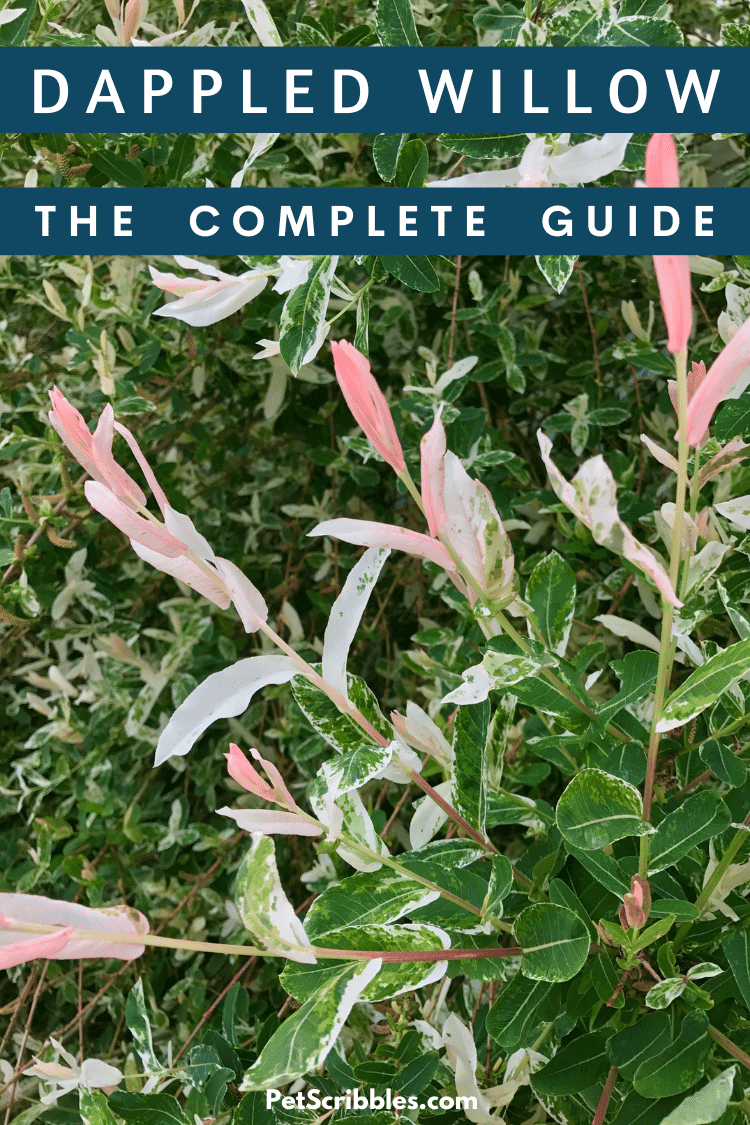
Do you have a wet spot in your yard? Do you want an easy-care plant that can handle wet spots? How about one with year-round garden interest plus a massive amount of fake flowers each Spring?
Wait a minute. Did I just say fake flowers? Yes I did, and you’ll have to keep reading to understand why!
The plant of your yard’s wet spot dreams is Dappled Willow, also known as Salix integra ‘Hakuro-nishiki’ Dappled Willow.
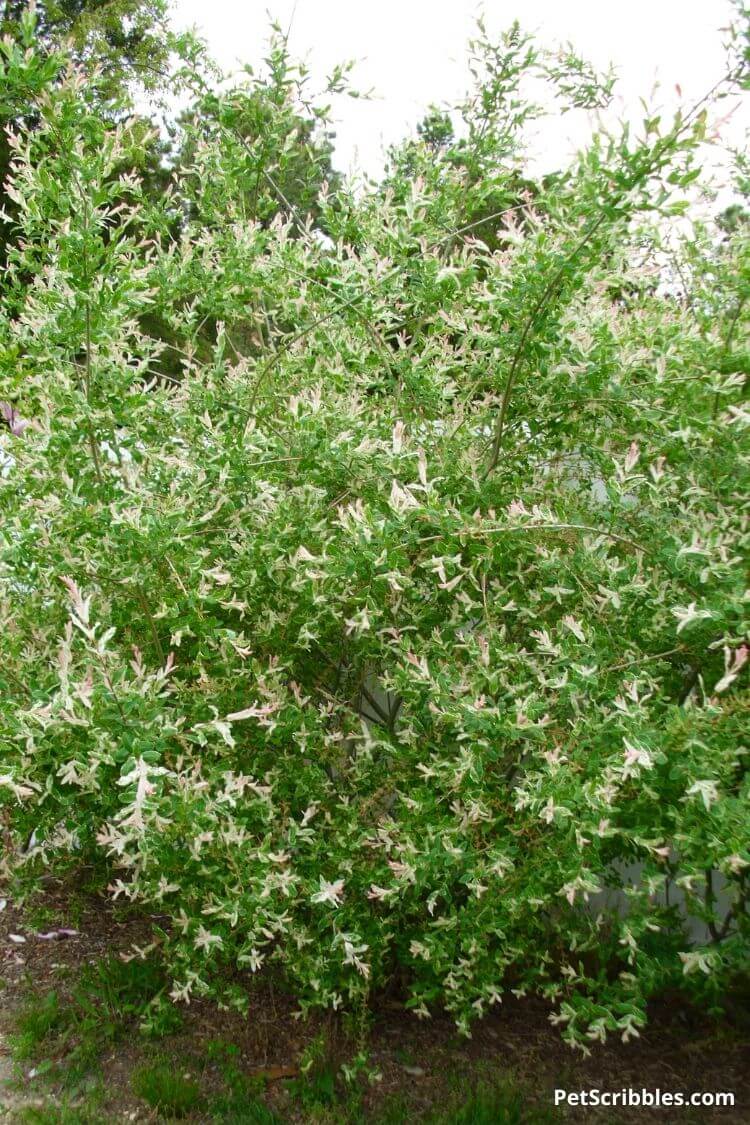
Dappled Willow is the perfect shrub to plant as a specimen or as a hedge. We have a long row of these beautiful shrubs in our back yard. We call these shrubs a living wall, as they provide privacy and nicely block our white vinyl fence (located behind them) from late Spring through early Fall.
Table of Contents
- The original Dappled Willow shrub that started it all!
- Rookie mistake planting Dappled Willow
- Giving the shrub a new (better) home
- Adding more Dappled Willow from cuttings
- Does Dappled Willow have flowers?
- Leaf Color
- Dappled Willow in Winter (red stems; snow damage)
- Growing Requirements
- Is Dappled Willow deer resistant?
- Is Dappled Willow rabbit resistant?
- Pros and Cons
- Pruning Dappled Willow
- Conclusion
The original Dappled Willow shrub that started it all!
Once upon a time, we were new homeowners with an actual yard where we could plant trees and flowers and shrubs. It was a magical time: no longer would we be confined to container gardening on a deck or balcony!
We headed to the local plant nursery, which was my own magic kingdom. Every type of plant I’d dreamed of growing was calling out to me. As I had been reading a ton of gardening books to prepare for this special moment, my husband trusted my judgment on what to buy and where to plant everything. (Yes, we still joke about this!)
Big mistake! I had a major garden fail. Bought way too much too soon. Rookie mistakes all over the place! I’m laughing as I think back to some of the gardening blunders I made. But that’s part of learning how to garden.
The original Dappled Willow shrub we purchased got caught in my excitement of planting too much too close together.
Rookie mistake planting Dappled Willow
The photograph below was taken in early Spring 2010, one year after planting our new garden beds in our front yard. Notice the Dappled Willow.
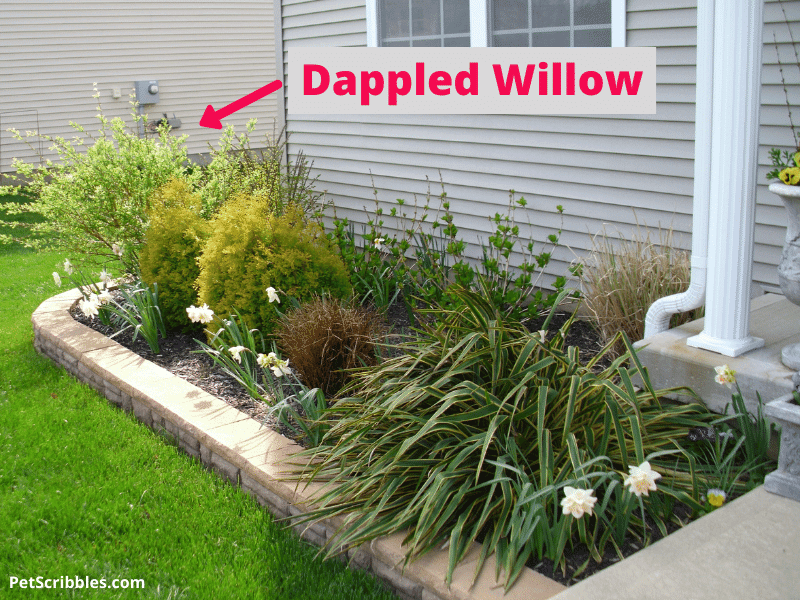
Apparently I thought one shrub was not enough. I planted six shrubs — egads, six shrubs — close together, including two Rheingolds.
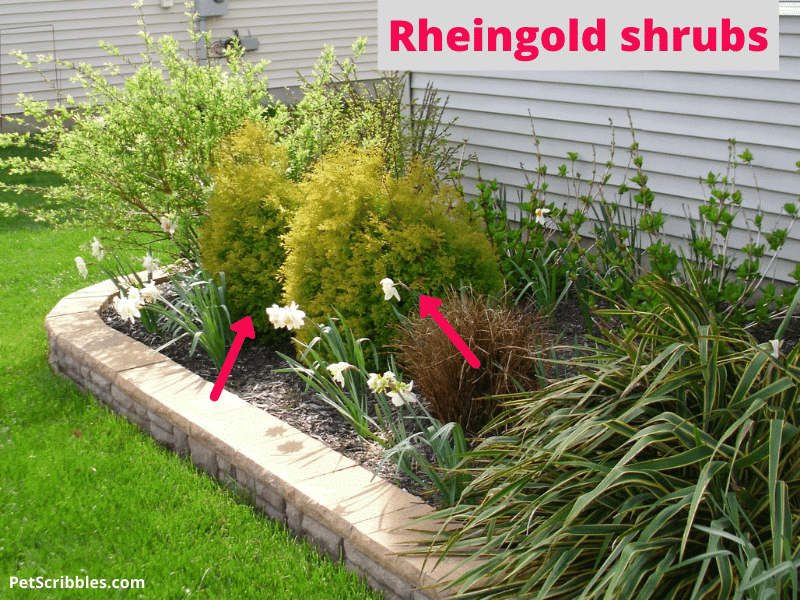
Even though the plant tags on the Rheingold shrubs clearly listed the height and spread as three to four feet tall and wide, I went ahead and placed those shrubs in the front of this raised bed.
Behind those shrubs are two Endless Summer Hydrangeas. There is also the Dappled Willow and a Burning Bush. Six shrubs planted in a very small amount of space. Most of these shrubs have since found a permanent home in our back yard where they have more room to grow.
Here is a better photo of the Burning bush planted behind — yes, behind — the Dappled Willow. Don’t judge me. I’ve already done enough self-judging!
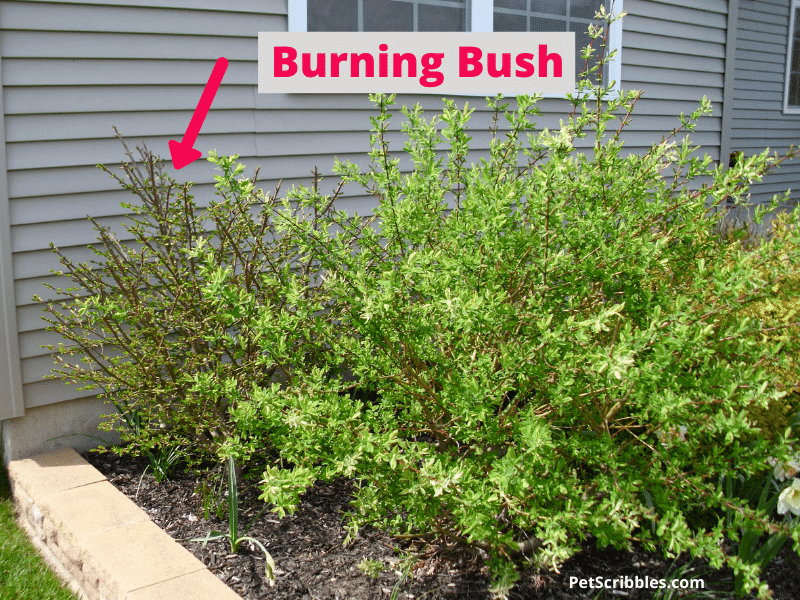
Giving the shrub a new (better) home
This Dappled Willow needed to be transplanted immediately! Of course, there’s no photos of it newly transplanted because this was BB: Before Blogging.
Below is the next photo I have of our Dappled Willow in May 2011, one year after being transplanted. In this area, we knew we could let this plant go crazy! There are three Dappled Willow shrubs in this photo, all from the original plant, which I’ll explain in a moment.
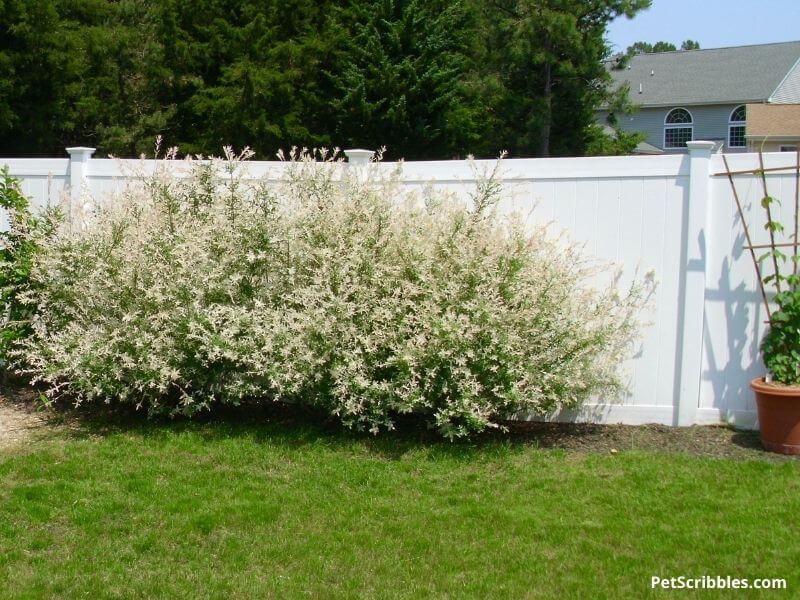
And here are the shrubs in May 2012, one year later:

Much bigger and more lush! The white fence is six feet tall, so you can get a sense of how quickly they grew from year to year.
We also have three Magnolia Jane shrubs planted next to the Dappled Willow. This side of our yard is so pretty in the Springtime with both the Magnolias and the Dappled Willow in bloom.
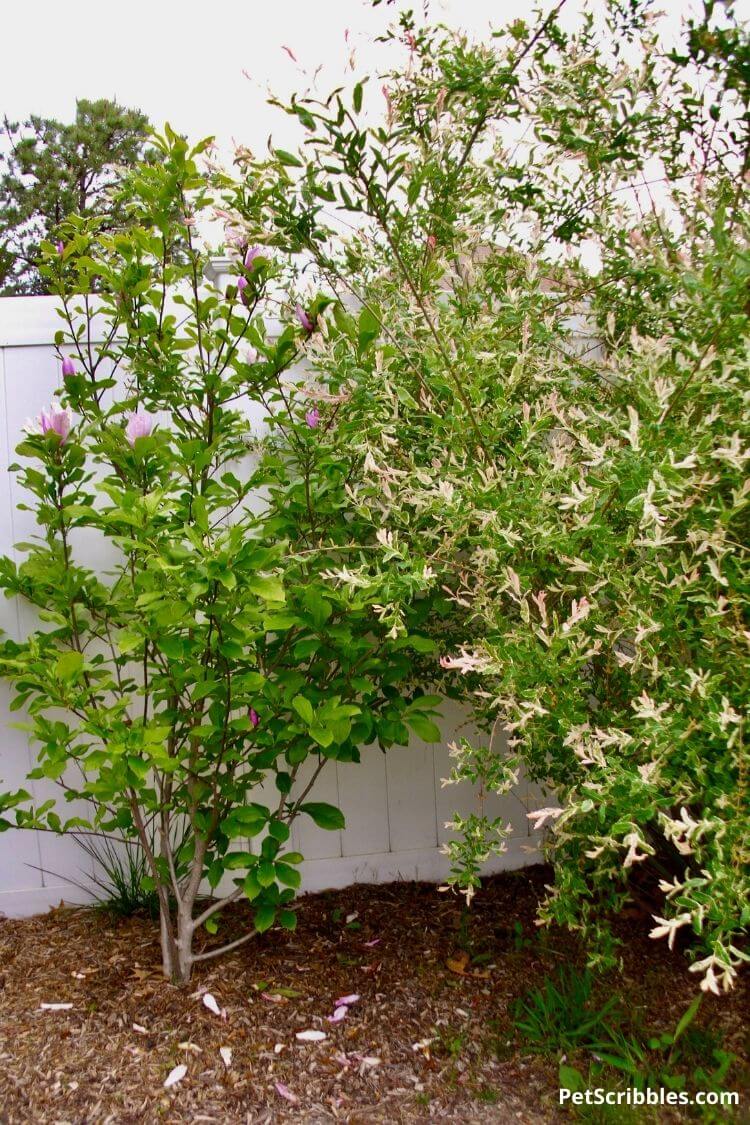
Adding more Dappled Willow from cuttings
We continued to add more shrubs to our living wall by growing additional plants from cuttings over time.
This began by accident, but oh what a happy accident as we learned just how easy it is to propagate Dappled Willow from cuttings.
One January, I cut some of the red stems from the original Dappled Willow shrub to stick into the urns by our front door. Easy Winter decorations.
Imagine our surprise when the stems began sprouting leaves in the Spring!
You can see these stems in the photo below. I carefully planted Spring flowers around them.
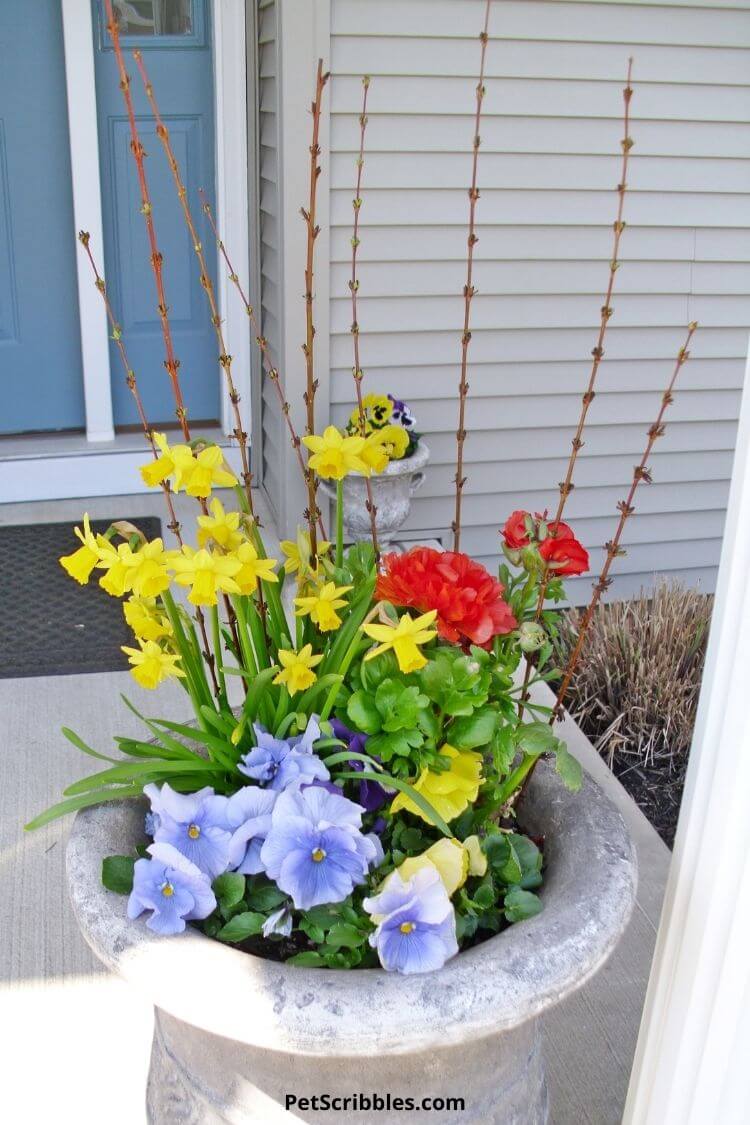
I’ve written a guide on how to successfully propagate Dappled Willow with simple cuttings. Click on the link to see step-by-step instructions. It is easy to do and can save you money as well. Buying multiple shrubs is expensive!

Does Dappled Willow have flowers?
Earlier in this article I mentioned fake flowers and also said this shrub looks pretty when it blooms. There is a very easy explanation.
The new Spring growth on Dappled Willow plants is a very pretty pink color. Many people mistake this new leaf growth as flowers — and they do look like flowers — but those are actually pink-colored leaves!
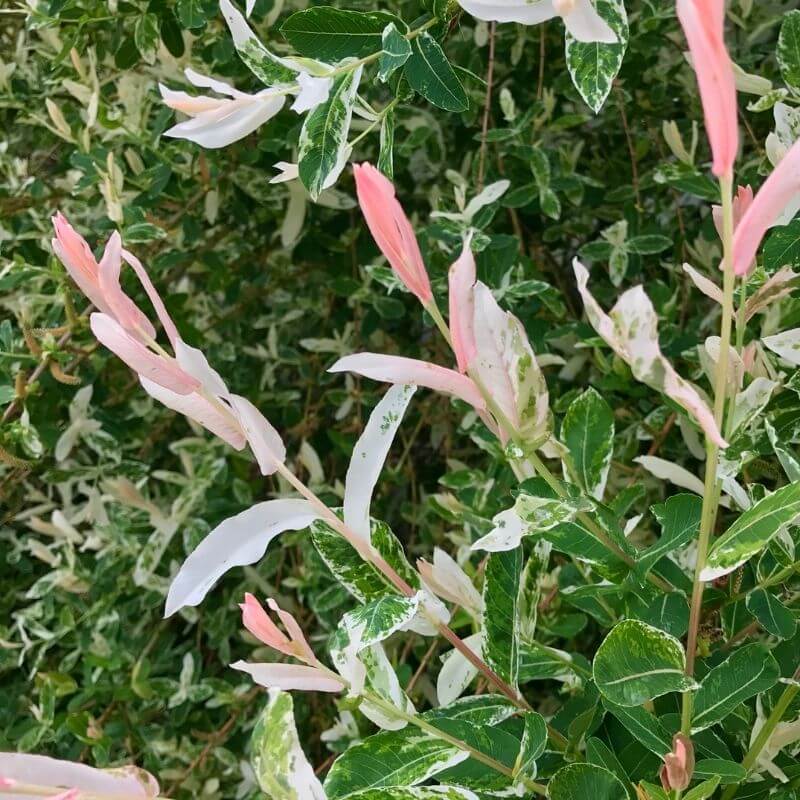
The Spring color is amazing as the shrub is covered in these pretty leaves. The pink color lasts a long time, versus some of the more fleeting Spring-blooming shrubs.
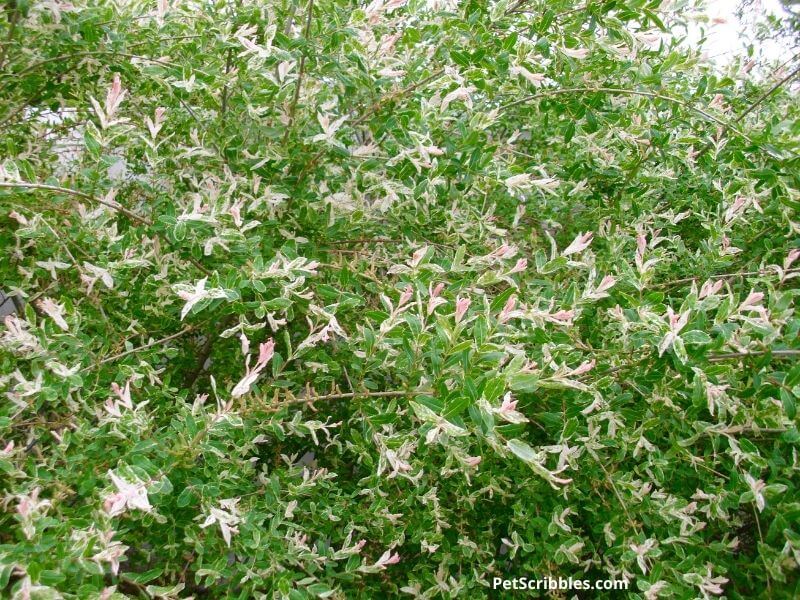
Leaf Color
Dappled Willow’s Spring foliage is a striking mix of green, ivory and pink. We had never seen anything like it when we first saw it on that magical day at the nursery so many years ago.
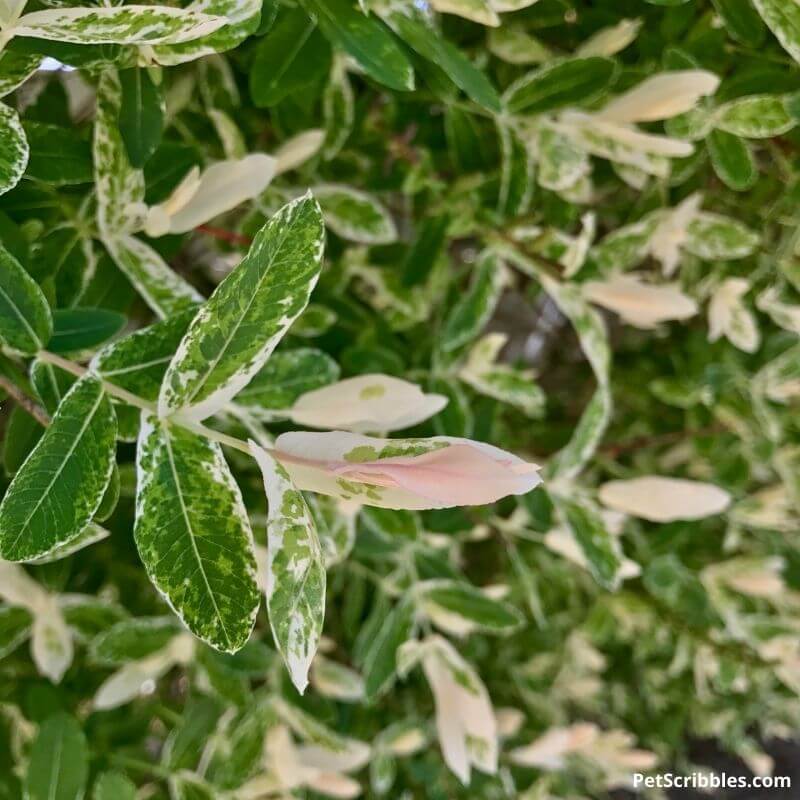
The pink leaves eventually fade and the Summer leaf color is a beautiful mottled — or dappled — ivory and green.
In the photo below, you can see how some of the pink leaves have spots on them. If you look closely, those spots are actually the *dappled* color that will turn ivory and green for the Summer.
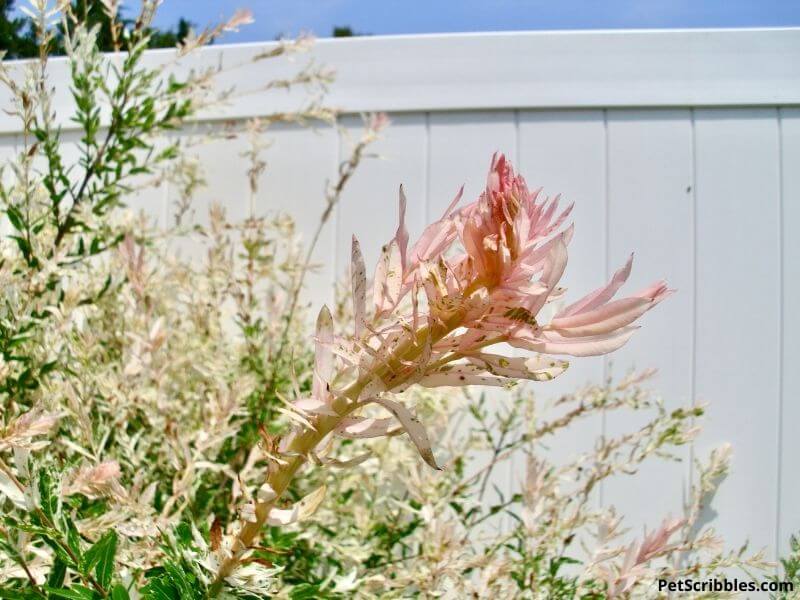
Dappled Willow does not have great Fall leaf color, with the leaves mainly turning yellow to brown before falling off.
Dappled Willow in Winter
Pretty red stems
Once the leaves are gone, there are pretty red stems to enjoy all Winter long. Newer stems are red — which is a reason why you may want to prune these every year. Older stems — including the main trunks of the shrubs — are more of a grayish brown color.
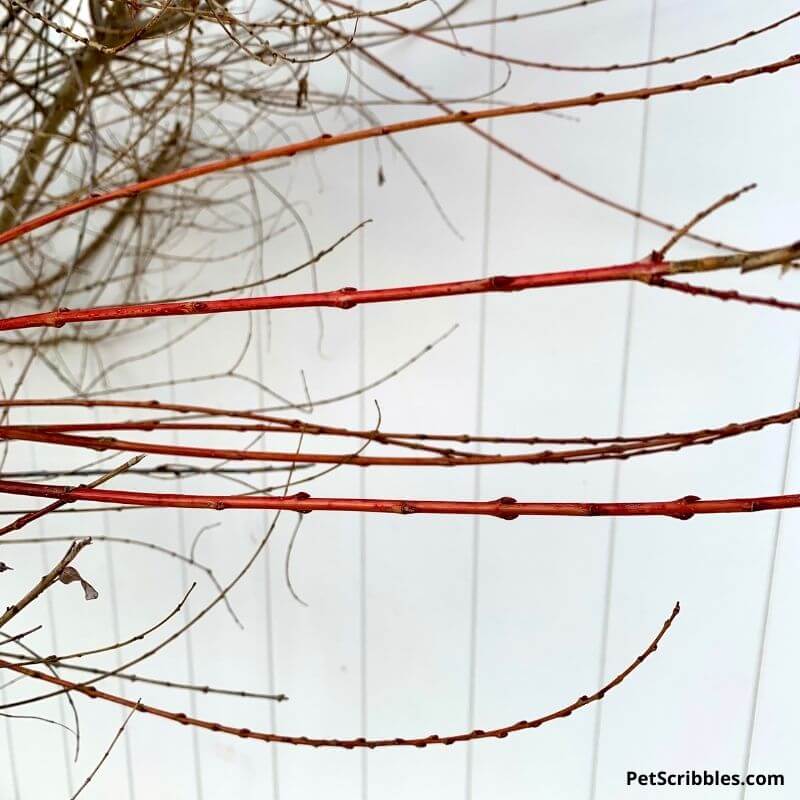
The red stem color is not nearly as vibrant as the stems of Red Twig Dogwoods, but the color is a pretty shade and looks nice against our white fence or when we occasionally have snow.
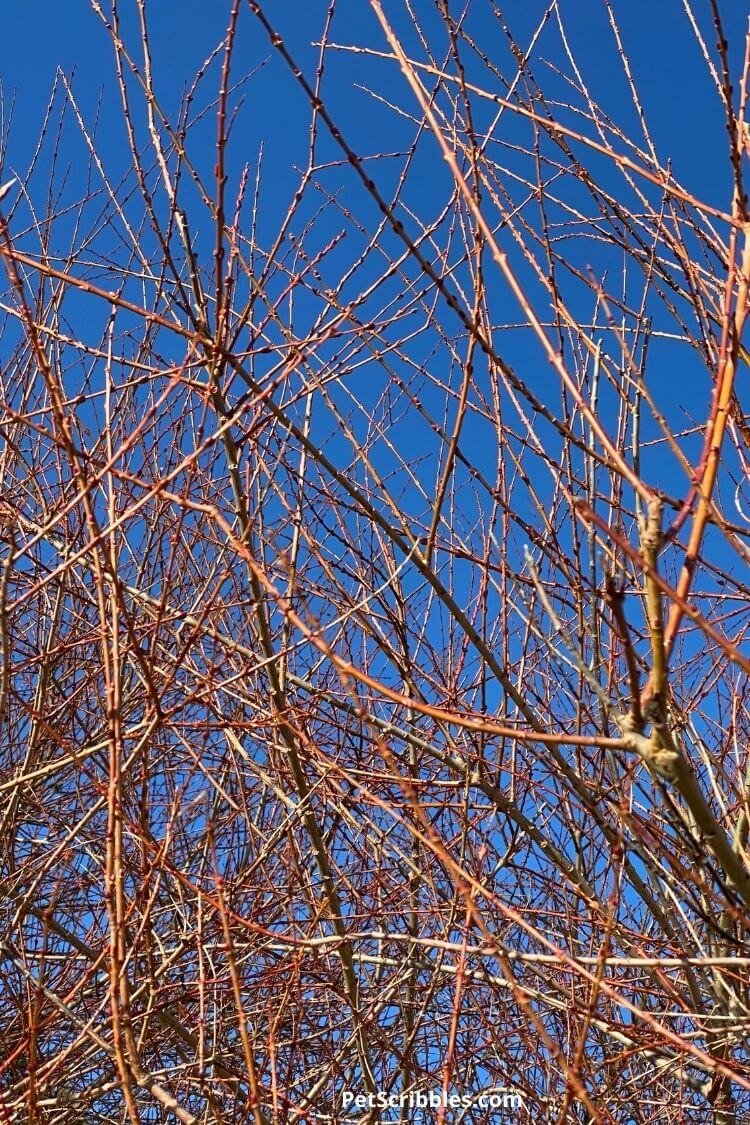
Snow damage
Normally, a light to medium snowfall will not harm Dappled Willow shrubs. When the stems are covered in snow, they look almost magical, as in this photo I took at dusk one Winter:
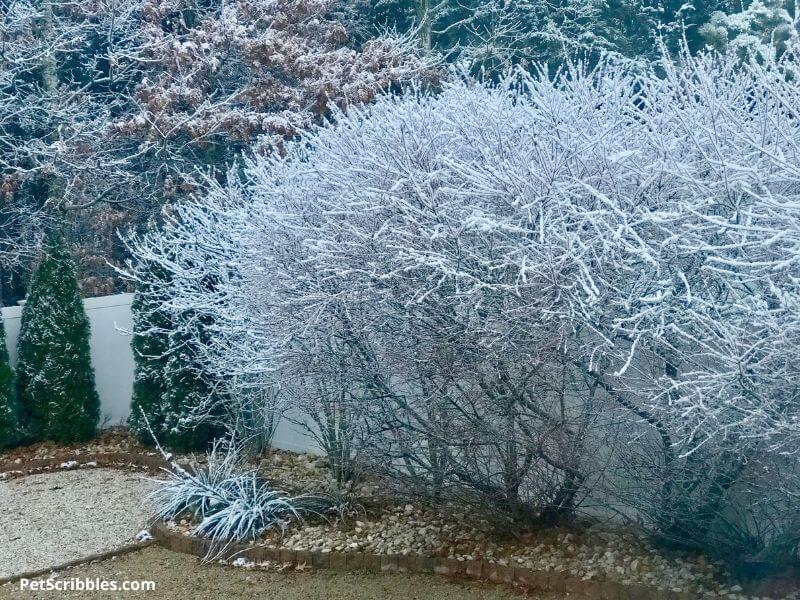
But watch out for severe Winter storms with heavy, wet snow. We had an early Spring storm in 2018 that completely crushed these shrubs, as this view out of our window shows:
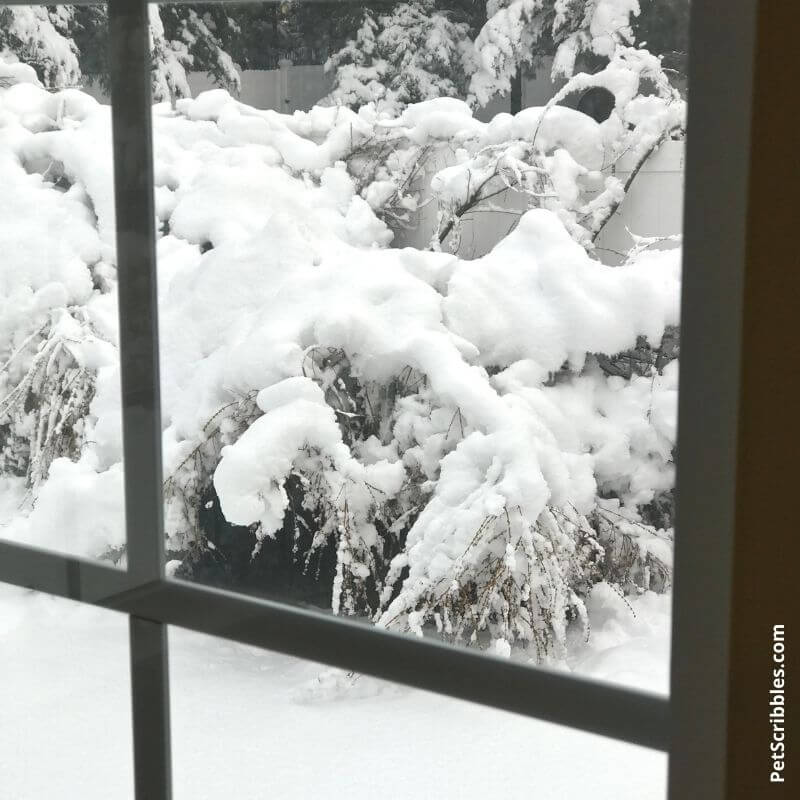
This storm occurred overnight, and as soon as we woke up and saw this, we were outside with brooms to gently push the heavy snow off without damaging the stems or branches. We were lucky that the shrubs bounced back.
Growing Requirements
USDA Zones: 4 — 9
Growth rate: fast!
Height and Width: 4 to 6 feet if pruned regularly; can grow much higher if left unpruned, perhaps 15 to 20 feet tall. To keep Dappled Willow smaller, pruning is essential.
Ours has grown between 10 and 15 feet tall. The width is hard to measure as we have grown ours as a living wall.
Growth habit: At first the growth will appear to be upright, but once the shrub is established, you’ll begin to notice the growth becomes curved and arches downward, almost like it is weeping.
Sun: full sun, partial shade. The best color is produced in full sun.
Spacing between shrubs: six feet apart, whether you are planting a row of Dappled Willow or planting them within a garden near other shrubs or perennials.
Plant them closer only if you are OK with pruning them, or if you don’t mind the stems growing into each other.
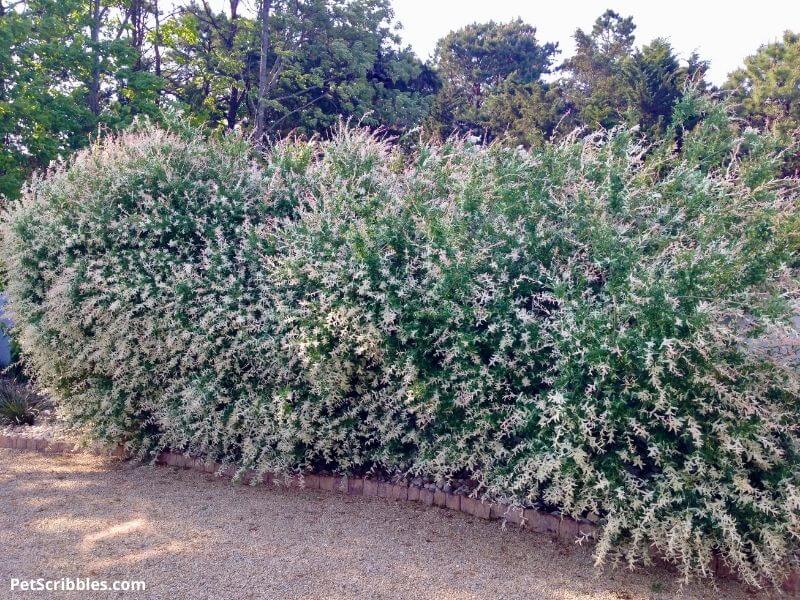
Water needs: loves moisture — especially first year. Don’t let the soil completely dry out.
Fertilizer: slow-release organic fertilizer, once a year in Spring.
Soil: adaptable, but loves moist and wet soils the best. That being said, my parents have a shrub — yes, grown from one of my cuttings — that is thriving in normal soil.
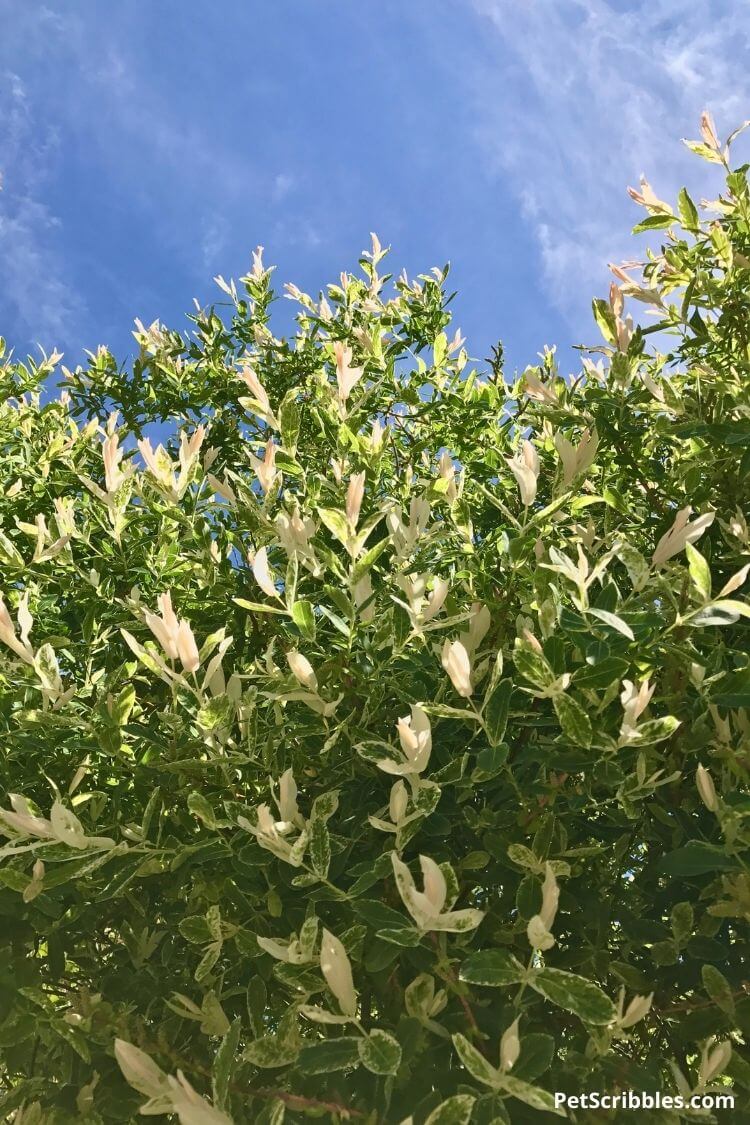
Is Dappled Willow deer resistant?
There is not a consensus on whether or not Dappled Willow is deer resistant. Some gardening experts say yes and others say no. When hungry, deer tend to eat just about anything. Dappled Willow is a fast grower, and that’s in its favor if it gets naturally *pruned* by deer.
Is Dappled Willow rabbit resistant?
Rabbits love to nibble on new shoots — especially in Spring — so make sure to protect your newly planted shrubs if they are small or young. Some people will surround the shrub with chicken wire, however I’ve seen rabbits dig under such things. They are crafty!
We have watched rabbits visiting our Dappled Willow to eat, but there is never any major shrub damage. I think they nibble on it as salad. (And of course I wish they wouldn’t.)
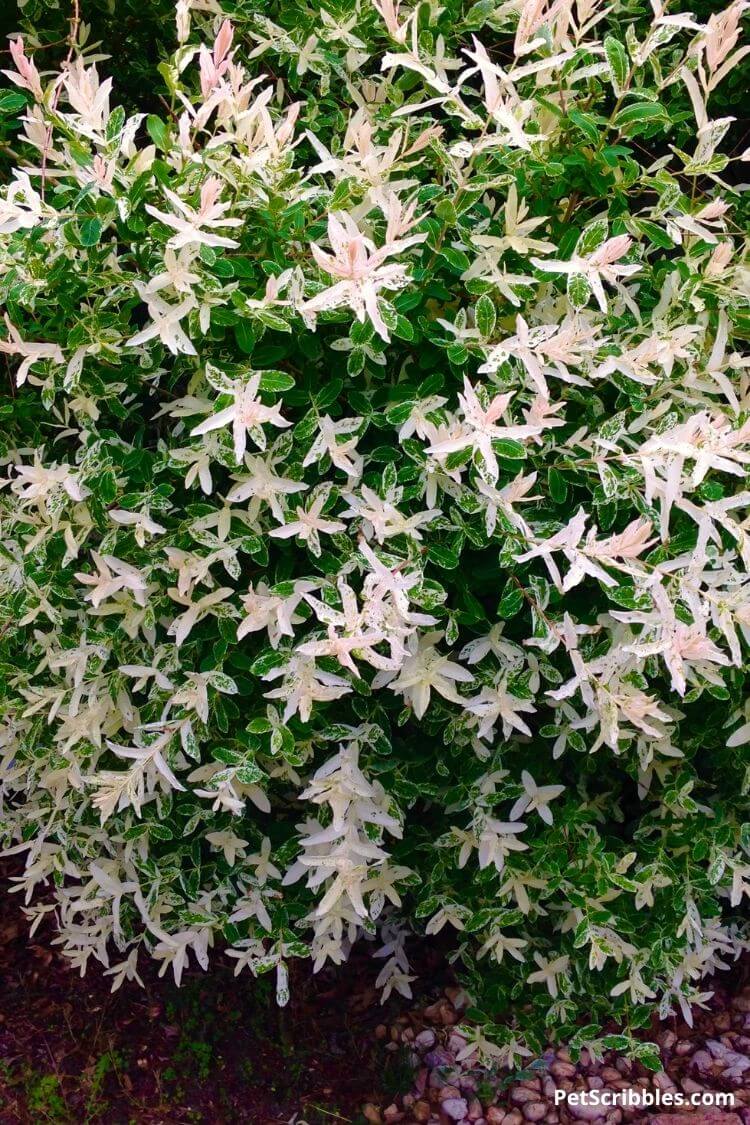
Pros and Cons
On the plus side . . .
- Solves your yard’s wet spot problem. It’s an easy-care shrub, as long as it gets enough water.
- Prune to whatever shape and size you want. This plant can fit into a more formal garden setting if pruned in a circular shape, just as it can fit into a more natural setting like in our back yard where we let it grow.
- Four season interest: red stems in Winter, pink leaves in Spring and dappled leaf color all Summer into Fall.
And a few things to be aware of . . .
- Avoid planting Dappled Willow near your water pipes, drains, and even any water features as their roots could end up causing problems. Just like any plant in the Willow family, their roots will seek out water.
- Make sure you plant Dappled Willow where it will have room to grow. (Don’t make my rookie mistake!) And be prepared for lots of pruning if you want to keep it within small gardens.
- Dappled Willow is a very fast grower. Very fast. We’ve seen some shrubs grow as high as 20+ feet tall. Ours is currently in the 10 to 15 foot range. The fast growth is wonderful for privacy screens or hedges.
- Pay attention to spacing between shrubs. Dappled Willow’s branches grow long, up and out from the main branches. If you don’t want to be constantly pruning, space them well apart from each other.
Pruning Dappled Willow
Dappled Willow can be pruned as much as you want, or not at all. And you can prune it into various shapes and sizes too.
Whether or not to prune your shrubs — as well as how often — is of course up to you. I’m sharing my own experience for you to learn from.
Important to remember: Dappled Willow shrubs are vigorous growers and enjoy lots of room!
Here’s what our Dappled Willow — next to our Magnolia Janes — looked like in 2013:

And here is what they looked like three years later:
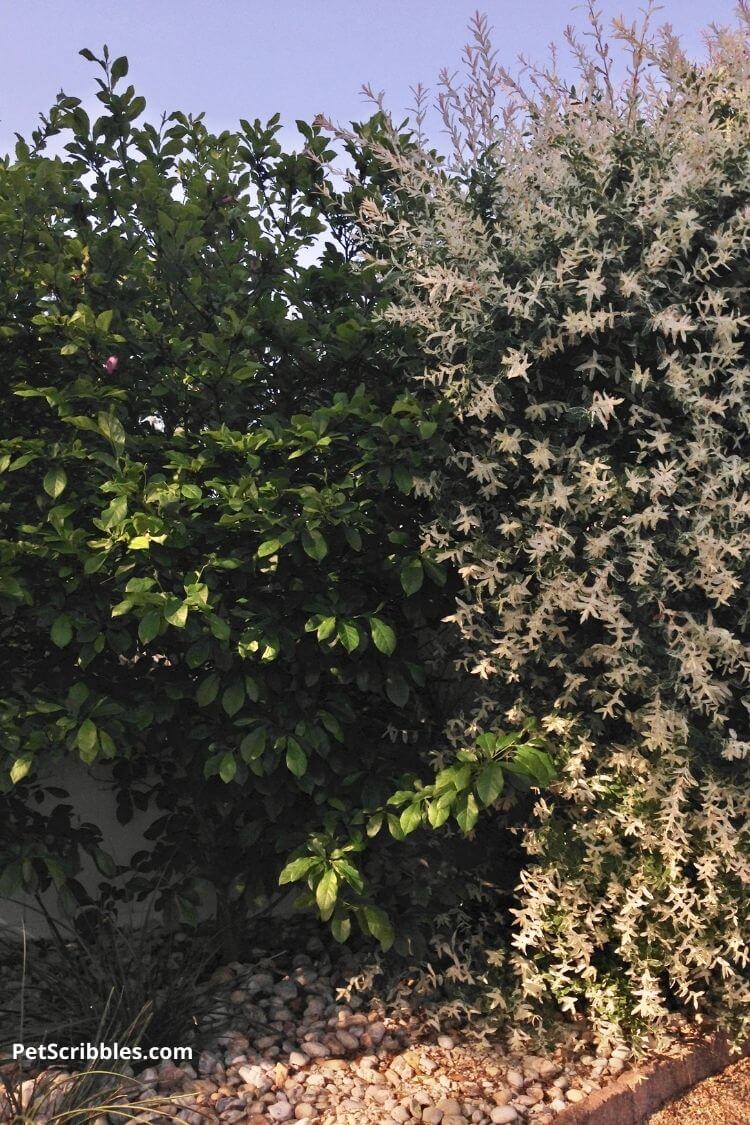
Just looking at the lack of space shows you the importance of not planting shrubs too close to each other.
I trim the Dappled Willow back a few times during the Summer and Fall to make sure it doesn’t take over our pretty Magnolia Janes.
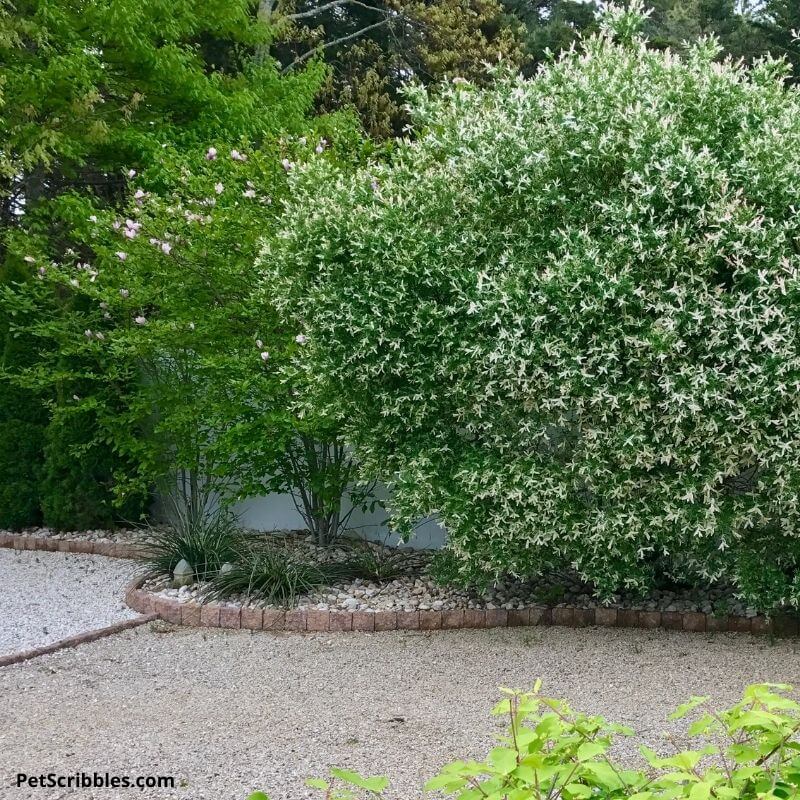
This shrub responds super well to pruning, so you can keep the Dappled Willow to whatever height and width you would like. Just remember that the more you want it to fit into a confined space, the more you’ll have to prune it.
When is the best time to prune Dappled Willows?
Either very early Spring before — or just as — the leaf buds start to show. Otherwise wait until after the gorgeous pink leaves are done blooming. The Summer leaf color is a variegated (i.e. dappled) green and ivory.

The image above shows you the height of ours. The white vinyl fence is 6 feet tall, and the Dappled Willow is between 10 and 15 feet high! The living wall is approximately 40 feet in length. Each shrub is planted 3 feet away the fence.
We trim it up perhaps two to three times a season, to keep the front of the shrubs fairly even with the stone edging.
And we also go over to our neighbor’s yard and trim back any branches hanging over into their yard as well. They love the look of it rising above the fence and enjoy the added privacy too.
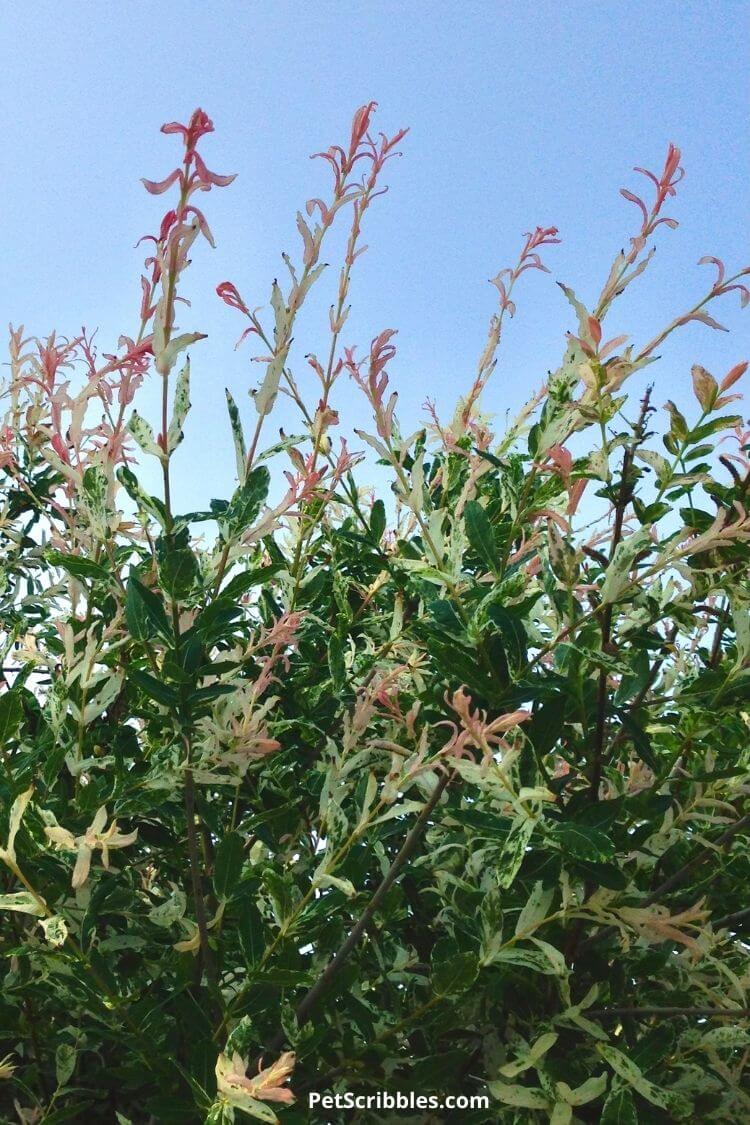
How do you prune Dappled Willow?
For the most natural look, use long-handled loppers and hand pruners. You can use an electric hedge trimmer, however this shrub is not meant to look as groomed as boxwoods, for example.
We have used a hedge trimmer in the past to quickly remove a lot of growth, but then we go in with our loppers and hand pruners to further clean up the shrub and make it look its best. In general, I’m not a fan of hedge trimmers for this particular shrub.
We also put a large tarp on the ground, to make cleanup quicker. This shrub doesn’t have sharp leaves or stems, but I always wear gardening gloves to make gripping the branches and stems easier.
How quickly do they recover from pruning?
Fairly quickly, as Dappled Willow are fast growers. For example, below is a photo of shrubs in April, about one month after pruning . . .
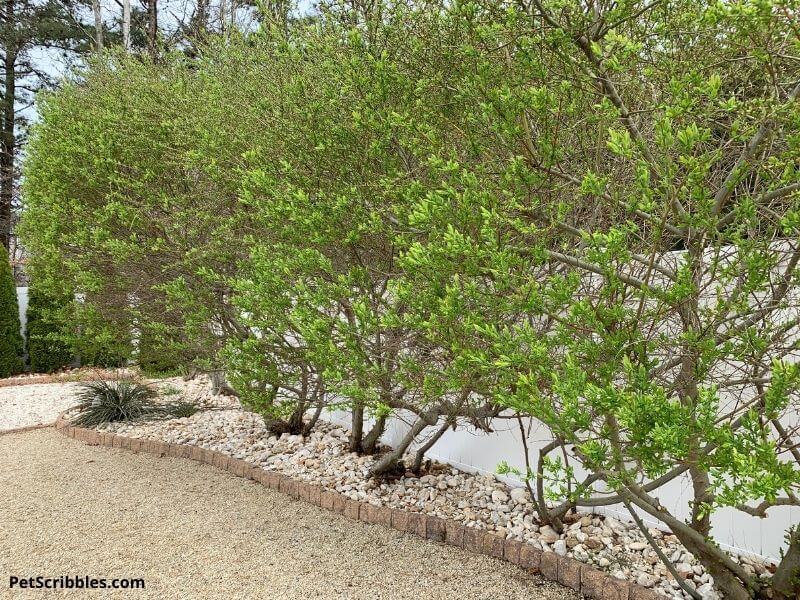
. . . and here are the same shrubs just two months later in June . . .
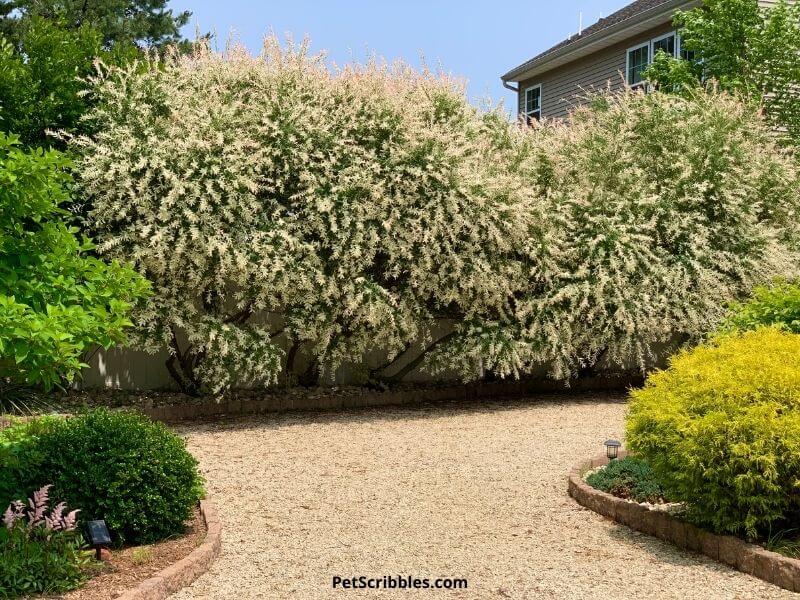
Can you prune Dappled Willow all the way down to the ground?
Yes you can! This technique is called coppicing, and will rejuvenate the shrub. As this shrub is a fast grower, new growth will sprout up and grow in nice and full. You will also encourage new red stems to grow which adds Winter interest to your garden.
Coppicing is a way to keep your shrub within bounds if you have it planted in a smaller space or just want to have a smaller sized plant. It is best done in late Winter or very early Spring while the plant is dormant.
Overgrown Dappled Willow? Coppicing is a must if your Dappled Willow has become overgrown. In fact, we did this to our own shrubs this year. Below is a short video about our overgrown shrubs, problems that arise and how coppicing will solve these problems. The second video shows you the actual coppicing.
Can you prune Dappled Willow into a tree form?
Yes, you can prune your shrub into a multi-trunk tree fairly easily. Remove any new growth from the lower two-thirds of your shrub while letting the upper stems grow. This will result in a lovely shape.
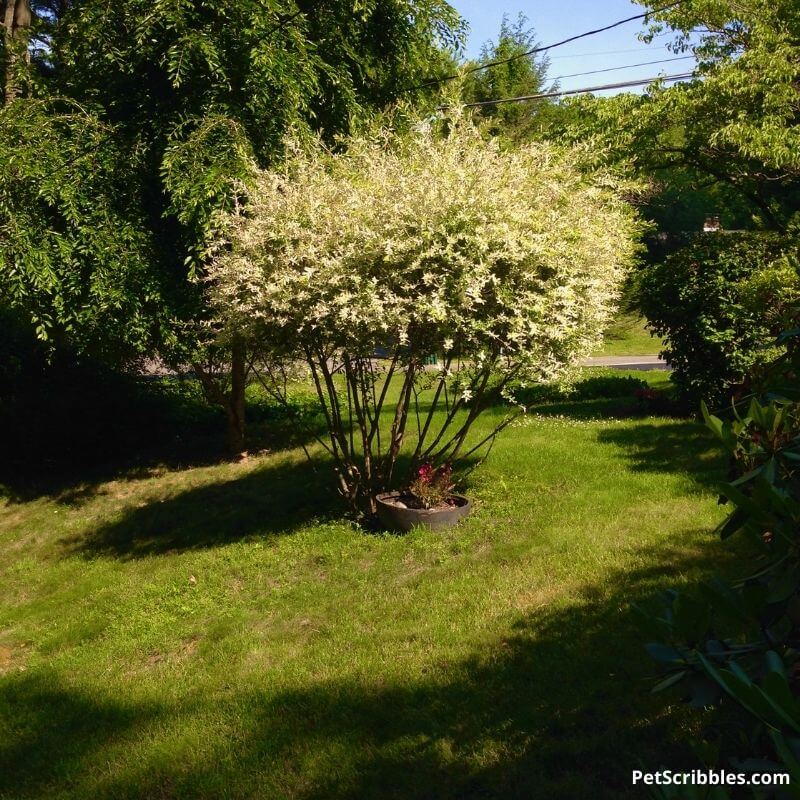
Garden centers and nurseries also sell Dappled Willow tree *standards* which look like one main stem with growth at the top in a rounded ball shape. These fit into a more formal garden setting nicely.
Conclusion
No matter what size shrub you have, Dappled Willow will add so much color to your landscape. Once established, it doesn’t require a lot of care. Just remember it enjoys water and room to grow.
I love this perennial shrub for its easy care, reliability, and of course its multi-season interest. I hope you will too.
Happy gardening!

Hello,
Thank you for the great info here. I have brand new dapper willows (planted spring 2020) and haven’t pruned them yet. I live in Michigan and do get snow up to the end of April or atleast a frost at night still.
My willows already have new red stem growth on them and buds. Is it ok to prune now or should I wait until May when I know the coldness is gone? I don’t want to damage the new growth and could really use some advice.
Hi Jennifer, It is ok to prune them now. If you see buds, it means they think it is time to start growing! Pruning them this early won’t affect the beautiful Spring color — the wonderful pink leaves. Another option is to wait like you suggested — but if you do — I’d suggest then waiting until after the Spring pink color is finished. You don’t want to miss the gorgeous pink color show! I hope this helps!
You are a Godsend! We bought our house 4 years ago. The man who sold it is supposedly a landscaper. More on that at a future time…….we have two dappled willows that were probably 2 years old at the time. I didn’t realize how fast they grow and they have gone from beautiful plants to monsters. I came across your video in YouTube about coppicing. I had decided to cut them back to the ground and your video showed me the way. I bow down to your expertise. Thank you, thank you.
Well you are most welcome Mary! I’m glad I could help! Yes, it is amazing how fast Dappled Willows grow, especially if they are happy where they are planted. Now your monsters are gone and beautiful plants will soon return!
Hi Laura, thanks for the great article!! If given adequate space, do you think one dappled willow would be ok as a foundation plant in a front landscaping bed? I have a row of 4 bowling ball arborvitae and a few perennials in the middle of one of my front beds. It looks too empty. I’d like to put one dappled willow in the center between two windows that are several feet apart. It seems like it would fit nicely if we keep it trimmed. I don’t like seeing the small shrubs and feel that we need some height and layering. But I am pretty clueless! 🙂
Hi Ashley, this sounds like it would be nice — however — I’m going to play devil’s advocate and pose some questions for you to think about before making your decision.
1. What size do you envision the Dappled Willow being, where you will prune it to maintain size and shape? It’s good to take a tape measure outside and try and visualize what height and width you will be happy with, as well as what height will drive you nuts. Keeping them pruned to 5 or 6 (or taller) is easier than keeping them pruned shorter.
2. How much sun does that area get? Dappled Willow enjoy sun for best leaf coloring.
3. How wet is that area? Dappled Willow love water, and you’ll need to make sure it gets a lot of water.
4. How much space is there to plant around your existing Bowling Balls and perennials? You’ll want to have your Dappled Willow at least 6 feet away from them. That can seem like a lot of space when the Dappled Willow is young, but trust me these shrubs grow and widen, even with pruning.
5. The 6 feet rule includes 6 feet away from the house foundation too, otherwise the Dappled Willow will be a bit smooshed toward your house as it grows.
6. Are you ok with the bare branches in the Winter season? Just making sure. It sounds like with the Bowling Balls you have some nice evergreen color for the Winter, but like I said, I’m just playing devil’s advocate!
Personally, I think it would look lovely IF all of the above conditions are thought through. I hope this helps with your decision!
Hi Laura, thank you so much. I think for the most part the answers to those questions work out ok… but perhaps the space is a bit tight. You had mentioned that yours are planted 3′ from your fence, so I had thought of planting them in the middle of the bed which is around 6′ wide. I envisioned keeping the willow 5-6′ wide and maybe up to 4′ tall.
I appreciate your feedback very much. I do want to make sure I thoroughly think through the decision so I don’t have to deal with trying to move the willow later. I want it to look nice and purposeful. Here is a link with some photos and more details, in case you might have any other thoughts: https://www.houzz.com/discussions/6261889/foundation-landscaping
Thanks so much again
You’re welcome Ashley! Yes, it’s a lot to think through, especially when you’re beginning to map out your landscaping. I think you’re being smart and taking it slowly. It looks like you’re getting lots of advice via the link you shared. My only suggestion is to make sure that whatever you plant, that it is something that YOU love, and not something you’re planting because someone else told you it will look good. You want to love the plants you have, and everyone’s tastes are different. Your own tastes and ideas are just as valid as anyone else’s, especially when it comes to choosing garden plants we will be staring at for years to come. 🙂
Thank you for your very informative article and videos. I am getting ready to plant 8 plants and want to use them as a privacy fence. They are going in an area that only has pine trees around so they will have plenty of room to grow. I read that you said to plant them 6 ft apart. If we want to let them grow wild naturally would 8 feet apart work since I have so much area to cover or would the 6 feet apart provide better privacy? Thank you.
Good question, Jill! As you could see from ours, these plants will grow into each other easily. I think — if I were doing this — I might go with the 8 feet apart as you suggest. Since you want to let it grow wild, it will have more room to spread out from the sides, yet still grow nicely into each other. Keep in mind that some pruning will be needed occasionally, so you can avoid the centers dying out, somewhat “inside” of each plant. Now, part of the reason we ran into this problem is because we are pruning to keep it more confined into its space. If we were able to just let it always grow freely, then yes worrying about the inside area of each shrub isn’t as important. I hope this makes sense? There are two videos I have on my YouTube channel about Dappled Willows that may also help you visualize what they will look like. Let me know if this answers your question. 🙂
Hi Laura,
Thank you for sharing this wonderful article! I’d love your opinion on a few things, if you would be so kind. We want to build a cottage on a small Bay and use a row of dappled willow for privacy. The problem is that once every 3-4 years, that area could possibly be flooded when we have super tides. The area drains fairly well so they would not be sitting in water for long periods of time. Do you think the Willow would survive salt water contact for a few tidal cycles if this happened? They sound quite hardy so I’m hoping that they will.
And question number 2. Our sewer is most likely going to be between the house and the row of willows. What kind of buffer zone would you give the plants to make sure the root system doesn’t affect the sewer bed? I know your answer would just be your best guess, and that’s fine. Whatever you say I’ll probably double the distance to make sure we have no issues. We have all kinds of space so I think we can make it happen. Thank you so much for your help!
These are all great questions Carol, and by the way: a cottage on a small bay sounds perfect to me! I think the Dappled Willow could survive occasional flooding, and what I would do is hose off the plants to avoid them getting any burn from the salt water, after they’re hit with the salt water tides. Just to be on the safe side. My guess is after the first time you experience this, you’ll learn how little — or how much — the plants are impacted by the salt in the salt water. As for the sewer, all I know is that Dappled Willow is supposedly not aggressive like Weeping Willows, for example. However, I would definitely consult a nursery expert — hopefully one conveniently located near where your wonderful cottage will be located. That’s what I would do, if it was me building the cottage. I’m not an expert on things like that, but like you I’d want to do it right the first time! Perhaps the sewer company might also be a resource as no doubt they’ve encountered such things. (At least I hope they could provide advice). I hope this helps somewhat?
Hello! Thanks so much for all the great information! I have recently purchased two small dappled willows and now realize the spots where I intended them to go won’t work. Too much shade, too small, etc. My next choice is actually in the front of the house with lots of space and sun BUT the area won’t be ready for a while, probably not till the summer of 2022. Since our plans aren’t concrete yet for that space, I don’t want to plant them permanently. Can they go in bigger pots until next year?
You’re in luck, Jackie! Yes, your Dappled Willows can go into bigger pots until next year! Make sure to provide them with lots of water as they grow, and you should be just fine. In the Winter season — not sure where you are located — you can keep them outside, but just move them nearest to your house, preferably in a sheltered area. They will go dormant, but you don’t want them to die out either. Periodically give them water during the dormant months IF there is a long drought without any rain or snow. They should be fine. (And how fun planning out your front yard too!)
Thank you so much, Laura! I’m in Canada, west coast, it goes below zero F once in a while here. Would they be better off in my garden shed? (no windows)
They should be ok outdoors in a sheltered spot, but yes they will be fine in your garden shed too. Just make sure to water occasionally, as if they would be getting natural rain or snow during their dormant (Winter) season.
Hi Laura
I just bought a grafted dappled willow. It was from Home Depot they didn’t know much about. The long trunk is not straight its very curved. I just planted it today. I attached a stake to it, will that help it straighten out as it grows. I live in Newfoundland we have lots of snow. Should I cover it in winter?
Hi Gerri, Are you in Newfoundland, Canada? (There are several Newfoundland towns here in the United States, so I want to make sure.) If you are in Canada, your Dappled Willow should be fine. These plants go dormant for the Winter season, so as long as you’ve got some mulch on the ground to keep the soil from drying out and somewhat insulated, your Dappled Willow should be ok. However, as you know, there are never any guarantees with Mother Nature! You mentioned purchasing a “grafted Dappled Willow” so I’m assuming you mean that you have a Dappled Willow tree form? Usually the tree forms have one main trunk. A trunk that is curved won’t bend and straighten out, but it’s great you attached a stake to it anyway. If the tree is planted in a windy location, the tree won’t begin leaning from being blown in certain directions. Is your tree the type that has rounded growth only at the top of the trunk stem? I would guess that as long as that top growth is somewhat “straight” then the curved trunk might not be as much of an issue as it grows taller. Hard to say, and I hope that Home Depot gave you a discount for the curved trunk. 🙂 Does this help?
We planted a dappled willow mid April. A week later had two nights of frost. Leaves look wilted and no more pink.☹️ Will it recover?
Thank you
Lynda
Hi Lynda, your Dappled Willow should be fine. You might lose the pink color, but the leaves will come back and should become the wonderful mottled, variegated colors of cream and green. Dappled Willow are very hardy, so make sure it has enough water and sun and it should be ok. Keep me posted!
Our dappled willow looks great. If the rain doesn’t stop soon may have another problem. The willow and I need some sun. Thanks again and have a wonderful day.
So glad to hear your Dappled Willow is doing fine! And I totally agree with you: three straight days of pouring rain doesn’t work for me! Here’s hoping we get some sun this week!
I keep hearing how invasive the roots of dappled willow are. Are they confusing it with willow. I want to plant it on the corner of my home but don’t want basement problems. I love them. Help
Hi Phyllis,
From everything I’ve read, my impression is that Dappled Willows are not as invasive as Weeping Willows, or Willows in general. However, I would definitely consult with either a nursery expert in your area and/or a sewer or septic tank professional. I don’t want to give advice that I’m not 100% sure of. I’m not an expert on things like that, but like you I’d want to do it right the first time! I hope this helps, at least a bit?
I bought my dappled willow last year and it was beautiful and growing so nice. We live 45 outside Chicago in the burbs. This year I have growth at the base but nothing at any of the stems that are shaped so nicely. What should I do.
Hi Linda, Are there any buds at all on the rest of the stems? I’m unsure what kind of a Winter season you had, but am wondering if things are late to leaf out? If the new growth at the base looks good and “normal” like Dappled Willow growth should, then perhaps the outer stems got too dry somehow and died? (I’m guessing here, without seeing the plant.) I’d let the new growth continue to grow, as this will be new stems that should grow quickly. If you’d like to send me a photo or two, you can send them to my email: [email protected]. PS — Don’t cut those bare stems off yet until you can be very sure there are no buds on them at all. Fingers crossed!
I live in Canada love the dappled willow great success in our last home.Huge show of pinks and greens and white ❤️
We have moved and I planted at least 1o new plants lSt year they are not showing the pink this spring
This is second year !
Do I need a little more patience?
Hmmmm this is a good question, Marilyn! Are you feeding the plants in the Spring with a good fertilizer? That is my first guess, that the shrubs might want some fertilizer. Fertilize a bit more heavier than normal, you can still do it now even though they are already leafed out. It might not help with the pink color this year — if that time has already passed in your area — but it will help overall with the coloring. Water the fertilizer into the soil well, and hopefully this will do the trick. How is the color otherwise?
Thank you so much for all these details! We have three of these planted in our backyard and they are beautiful! They’ve become overgrown the past couple of years, so I followed your advice for a good pruning and cut a lot of dead branches off. I’ve noticed that the leaves are more green than pink, but it may be too early in the season yet. Your video mentioned that more green than pink could be a result of the overgrowth, though. Did I understand that correctly or could it be diseased? I can’t find any details about this online, so just hoping for some more advice! I’m also thinking about coppicing next year depending on how they do this year. They look much healthier without all the dead branches on them though. A big improvement! Thanks for any thoughts on this!
Hi Ashley, The green leaves are from being a bit overgrown. No worries about disease, so you’re good. Yes, I agree that Dappled Willow can instantly look so much better when all of the dead branches are removed! Wait until after the Spring season, once the “dappled” color fully kicks in. If, during the Summer, you still see green leaves, I’d cut those off at the base of that stem (that the leaves are on). Hopefully there won’t be too many of them. This should fix the shrubs nicely! I hope this helps!
Excellent – will do! Thank you so much!
My newly planted willow I has yellow leaves on the bottom and dry leaves on top …
What’s happening ? Watering too much or not enough. Help!
Hi Sandy, If there’s dry leaves on top, I think your Dappled Willow is telling you it wants more water. Yellow leaves — unfortunately — can be confusing and mean BOTH not enough water or too much water. So…the dry leaves makes me think it’s needing more water. In general, Dappled Willows LOVE water, and so give it a nice long drink. I hope this helps!
I planted 4 plants last summer. I live in Nova Scotia Canada. We have lots of snow and late spring. This is the end of May and we are now seeing the beginning of new growth. My 4 on the south side of the house are growing and look healthy. The one in the front, gets a north wind and that side of the bush, the leaves all turned brown and looked terrible. Today I cut those stems down hoping that it will recover with summer coming…I hope I have done the right thing?
Yes, Christine, no worries because Dappled Willow is amazingly resilient! It will bounce back, even if it takes a bit of time. When you cut the stems down, did you see green? If so, you’re all set. BUT — even if you didn’t see any green: new growth will sprout out of stems that you think are dead. You can watch an “update” video on my Garden Sanity YouTube Channel where I show how what looked like dead stumps just two months ago are now covered with new growth. It’s funny — and frustrating — how our plants can grow so differently depending on where we have them in our landscape. Keep me posted!
I am worried that it is a fungus. New leaves come and then turn brown…should I cut these off and let it come up from the bottom again? I have 4 others in a different location and they are beautiful with new growth. I am in NS Canada.
Hmmmm… This has me stumped Christine. What makes you think it is a fungus? Is it because it continues to happen with the new growth? How does the new growth — that’s coming up from the base — appear? Are the leaves fine, or also getting brown? Also: is the shrub getting enough water? These shrubs love water, and the leaves will turn brown if it is drying out. Wind can really dry out plants, and it always surprises me how much wind does dry out even what I think are well-watered plants. That could be all it is. Also, add some slow-release fertilizer mixed into the soil around the shrubs too. Just to give it a little encouragement. Let me know if the water improves the shrubs. (I’m still not ready to agree it is a fungus — but that’s a good thing!)
HI again. I cut it back and it came back fantastic no spots this time!!
I do have another question. I have four planted as a hedge. The branches grew out and not up so they look like spreaders. Will they eventually grow up and tall?
So happy to hear the Dappled Willow look great this year! Wonderful news Christine! Yes, these plants do seem to spread and grow into each other, but never fear — you’ll also begin noticing they are growing taller too. One way to notice it, is to take a picture today. And then take another one in a month or two. I do that all the time, because when I’m looking at the same plants and shrubs every day, it’s hard to notice growth sometimes. It sounds like yours are doing well, and that’s awesome!
Hi Laura,
I need your expert advice.
I planted our dappled willow (tree form) last September in a spot that gets full for a solid 6 hours and filtered sun/shade for the remainder of the day. It was beautiful and lush for the first several weeks this spring and filled in beautifully. Then I noticed aphids on the new pink growth, and ants parading up and down the truck. I put sticky tape around the base of the tree stop the ants and I started manually taking the aphids off.
To make a very long story short, I tried all the organic approaches (including neem oil) but the problem grew worse and now a solid 65% of the leaves are gone. The remaining leaves are curled, browned, and otherwise damaged.
I believe I may have triggered the infestation by stressing out the tree. I did not put mulch around the base of the tree, and I did not water it at all during a three-week period of warm sunny weather in early spring. I am new to gardening, so unless someone explicitly tells me what needs to be done, I assume nothing is needed. I put some slow release fertilizer around the tree at the beginning of spring and thought my job was done. I didn’t get any watering instructions, and no one let me in on the secret wonders of mulch.
The mulch is now down. I give the tree a bucket of water every day (two on hot days), I have reached for the nuclear option and sprayed the tree with insecticide (second week now), I have trimmed off the new infested growth, and I am feeding the tree transplant fertilizer once a week to encourage recovery and to promote new growth. I am seeing new leaves form, though I am also seeing new aphids on the tree.
Is there anything else I could/should be doing that I am not doing? I am in love with this tree and I want it to thrive. It pains me to see it all tortured and suffering. What have I missed?
Wow — those aphids sound like they are mutant aphids! I sure wish that insecticide would have helped. I suggest using organic insect soap. There is a fabulous product by Espoma called “Organic Insect Control” and it kills insects — including aphids — on contact. It is a spray. You shake well, then spray and wet the leaves — although NOT to the point of dripping liquid. (And don’t forget to spray the undersides of leaves too.) I think you need something like this. After spraying, wait a day, go out and see what everything looks like. Hopefully there are dead aphids. Follow label directions. (Hoping this helps get rid of the aphids.).
The trouble with using general insecticides is that they often will kill other insects that are needed to help control the bad insects. So it’s possible that there’s nothing at the moment alive to attack the aphids, which results in more aphids instead of less. I know: it is beyond frustrating.
More ideas: in between the spraying of insect soap — which I think they suggest is once every week or two — use a hose to remove the aphids, especially if there’s no rain. That’s easier than hand removing them. And if you have a local nursery that sells live lady bugs, purchase some and put them in your garden around your tree.
Everything else you are doing is great. Mulch sounds good, watering sounds good. Don’t over-fertilize is one thing I would caution. That can also stress plants and trees. I hope this helps! Keep me posted!
Thank you so much. I will look for the product at the nursery and order it if they don’t have it in. Yes, my local nursery said they would have ladybugs in by summer, which is unfortunate timing as I understand aphids tend to be mostly a spring issue.
Today I walked past a gorgeous, established dappled willow and stopped to inspect its new pink growth. I was surprised to find it covered in aphids, just like my tree. Even more surprising was that the plant seem completely unaffected by their presence and looked to be thriving. This made me wonder if the aphids were an unrelated problem and the real problem was my underwatering, or if my tree was particularly devastated by the aphids because it is not yet established. (Or some combination of these two things.)
Are dappled willows usually able to tolerate aphid infestations reasonably well?
Aphids are never a good thing, so even if you see it on other shrubs and the shrubs appear to be great, I can’t imagine it will remain that way. Aphids also aren’t just a Spring issue, unfortunately. They will pop up whenever they feel like it, if conditions (to them) are right. In the meantime, your hose nozzle — to rinse them off the Dappled Willow — is your best friend. Make sure to give the tree enough water too. The ladybugs should come in handy, so I’d still recommend them, plus the Organic Insect Control Hang in there Garden noob — you’re doing a good job!
Hi Laura! Your shrubs are absolutely beautiful! This might sound strange but I recently just discovered an area in my yard to put a shade garden. It had been covered in lilacs for years. Unfortunately the shrubs did not survive the winter of 2020 and so as we were ripping them out I discovered this magical place I’m calling my secret garden!
The front of the garden gets probably 3 to 4 hours of sun while the far back is pretty much full shade. I’ve been admiring the dappled willow now for a couple years but just didn’t necessarily have a place to put it in our yard. Since now that I need to add some shrubs back to replace some of the dead lilacs, I’m very excited to see the beauty and personality of the shrub in my secret garden.
So to my question… Sorry that was a long way around… Do you think 3 hours or so it’s going to be enough sun for this lovely gem?
Hi Nicole, Finding a new gardening space isn’t strange at all. Just last weekend, I dug up a small shrub that was driving me nuts, and was amazed at how much “new” room I have to plant other things! Your new secret garden sounds like so much fun to put together! The best color on Dappled Willows will occur if they are planted in full sun, however, partial shade also works. My parents have a large dappled willow shrub (taken from one of my cuttings) sited in mostly shade and it is doing quite well. Make sure to remember these love to spread out, so don’t plant the shrubs any closer together than what I list above in my guide. 🙂 Also know that anything planted in front of them should be placed at least a few feet in front of them. The front branches will eventually arch forward. Yes, you can prune them, but it is easier not to have to worry you planted things too close together. (Learn from my mistakes! LOL) Not sure where you are located, but another benefit of partial sun/partial shade is if your Summers are very hot. Shrubs always appreciate a bit of shade to cool off from the hot sun. Keep me posted on what you decide. This sounds like a wonderful project!
Hi Laura – We currently have 2 very large (about 10′) dappled willows in our back yard that were here when we bought the house. I’m a little concerned about the root system being too close to a water source (septic). Is it possible to transplant a shrub this large? I absolutely love them and would hate to damage them, but I know willow roots can be very invasive. Thanks!
Hi Sandra, I can only imagine how big the roots are underneath the ground on a 10′ Dappled Willow shrub! Supposedly Dappled Willows are not as invasive as Willows in general, however I totally understand your concern. I’m not sure if removing the Dappled Willow — in order to transplant it elsewhere — is something you could do yourselves. I’m not doubting your strength — LOL — but I’m doubting you have the professional tools to truly get at all of those roots down there. If they aren’t all removed, you’ll still get “new” Dappled Willow plants sprouting up in that area from the roots remaining there. It sounds like a job for a professional tree service. We recently had our “tree guy” as I call him — a certified arborist — remove two dead magnolia trees for us. I was amazed at the amount of roots they dug out of the ground, as well as how thick those roots were. They were huge!! My husband and I were so thankful we didn’t attempt this ourselves! If you go with a landscaper, make sure they can remove all of the roots for you, as not all landscapers may have the professional tools needed to dig out those roots.
You don’t need to transplant “all” of the roots, but you will want to have them remove as much as possible for you. My other suggestion would be to trim down your Dappled Willow to a more manageable size — say about 5 feet — before removing and transplanting. (These shrubs grow back quickly.) It will just make things easier for you. You will want the new spot you choose to get enough water, as these shrubs love moisture. And sun for best color. When transplanting an existing shrub of that size, it might go into somewhat of a shock and appear to be dying — BUT — hang in there as it will rebound. We experienced this when we transplanted our original shrub in the middle of Summer years ago, and it looked awful for about a month until new growth took over the small dead brown leaves. I hope this helps. It sounds like a major job, but is also sounds like the type of job that once you have it done, you’ll be much happier! Let me know how it goes, and I hope it goes smoothly for you!
We’ve had a dappled willow tree for quite a few years. This year 2 major branches have died on it. Do they have a life cycle?
Hi Susan, I guess I have several questions, which may not initially help you. I’m curious as to how thick the 2 branches are (or were)? Also when you say they died, is it because there are no longer any leaves on them? No knowing these answers, if it happened to me, I’d just cut those branches off. No, there isn’t any life cycle for Dappled Willow — or their branches. In the past, if I’ve seen a branch looking like it is dying, I wait to see if there’s any new growth — for example buds — beginning to form on it. That will usually happen with any branch that looks dead. Another idea is to gently scrape the outer edge of the branch to see if it is green inside. You may have already done these things. If the rest of the shrub looks healthy, I wouldn’t worry about it. How does the rest of the shrub look?
Hi Laura
I really enjoyed all the information that you wrote. So many questions I had were answered. I do have a question myself though. I planted 3 Dappled Willows last year towards the end of the summer. They have done very well but are not as full as I had hoped. Will this happen soon? I live in Tennessee. Also I may have made a mistake in the area I planted them. They are about 10 feet from our septic tank. Is this a problem in the future?
Thank you
Shirley Stowe
Hi Shirley, I’m glad my article was able to help answer some of your questions! I think your Dappled Willows just need a bit more time to settle in. They are probably still getting established into their spots, since you planted at the end of the Summer last year. They went through a dormant Winter season, where all growing stopped for awhile. No worries. Make sure to feed them a good slow-release organic fertilizer to help them. Also, these shrubs love water — especially when young and still getting established. So make sure to give them enough water.
As for the septic tank issue, I’m honestly not sure. This is a question that does come up from readers, and my advice is always to consult with either a local nursery expert (hopefully you have a good garden nursery nearby) and/or a sewer company or septic tank company. They can advise best, and that’s what I would do if I had this question. I hope this helps, and if it is suggested you move them, at least the shrubs are still young. Keep me posted on how the shrubs are doing!
Well, I am just sick. Went out to water my brand new dappled willow and it is gone!!! Guess the bunnies ate it!! There is very little of the stem even left so I doubt if it will recover.
Oh no Carla!!! That’s horrible, but it seems like many of us are experiencing crazy rabbit damage this year like never before. It probably CAN recover, so don’t lose hope. First, try and repel the rabbits by sprinkling Repels-All (by Bonide) or spraying Liquid Fence, following package directions. Next, if what remains is small enough, purchase a wire cloche that you can place on top of the remaining plant so that it can start to grow back without the rabbits getting at it. There are many varieties for sale on Amazon and elsewhere. Dappled Willows are very strong so all is not lost. Well, except for how you’re feeling and I totally get what you’re going through, as the rabbits here have devoured certain plants of mine as well. It stinks. Let me know if these things help!
I absolutely love dappled willows and planted two of them. It only took a few days for the bunnies (and I think deer too) to eat them down to the ground. I am heartbroken. Do you think there is any chance they might come back?
Wow, Martha. It sounds like you’ve got some “pandemic rabbits” as I call them. Rabbits have been eating so many things last year AND this year that they only used to only nibble on years ago. So sorry to hear this — BUT — the good news is yes, your shrubs will come back. The first thing to do is to protect them from the deer and rabbits while they grow back. (Dappled Willow are fast growers, which is good!) I’m not sure what will work best for you in terms of deer, as thankfully I’m very fortunate not to have a deer problem. While the shrubs are so short, you could put temporary chicken wire around them to keep the deer and rabbits at bay. Depending on how big or small they are in diameter, you could also try a wire cloche to put on top of them. Most importantly, you will need to spray regularly with a deer/rabbit repellent, following package directions. If it was me, I’d spray the area surrounding the Dappled Willow as well, just to hopefully keep them away.
In my own case this Summer, the rabbits are destroying certain shrubs while leaving others alone. They are nibbling the Dappled Willow but so far, so good. Even so, I regularly sprinkle Repels-All granules (by Bonide) all around each shrub to keep the rabbits at bay. Sometimes it works, and other times I think the rabbits have stuffed-up noses and just don’t smell the bad smells designed to keep them away. I hope one of these preventative measures helps your Dappled Willows grow back. Keep me posted!
Hi Laura,
I live in South Jersey and have 5 Dappled Willows. Thank you for educating me on how to cut down (not remove) my overgrown shrubs to a height I can handle. When is the best time for me to do this here (08234) in NJ? They are sooo out of control now, didn’t tend to them as I should have after my husband was diagnosed with cancer. Sadly he passed and want to keep our house and yard as nice as it was when we worked at it together….. now I have to take control of these shrubs…..but What month? What do I look for on branches,etc to let me know it’s safe? Thank you so very much! I love these shrubs!
Hi Martha, First, my deepest condolences on the difficult loss of your husband. Working on your garden will indeed be such a nice way to remember the two of you working together on projects. I wish you much peace with your gardening efforts.
Above in my article, there are two videos that I’d suggest you watch if you haven’t already as they may answer some of your questions on what to look for. If they are overgrown, cutting them back severely is a great option to get them back under control. Go to the “Videos” section of this website to see another video on how quickly my Dappled Willow grew back after cutting them down severely.
As for what time of year, and knowing you’re just south of me…where we are getting hit with such a horrible heat wave right now, I would avoid cutting them back during the high temperatures of the Summer. The best time would be late Winter or early Spring for such a severe pruning. However, you could also do this in late Fall too. A great reason to also wait until the leaves aren’t on the Dappled Willows when you prune them, is so you can see exactly what the branches look like. In our case, which you’ll see in the videos, the main trunks all grew in a leaning, almost horizontal way, which was not what we wanted. So now we have started over and will keep a better eye to have them grow upright. (We hope!)
As for what to look for on branches, you don’t have to be particular at all with Dappled Willows, which makes pruning them very easy. No matter how much — or how little — you cut it back, new buds sprout up within days sometimes so quickly it is amazing! Just decide how low you want to go. You’ll see in my videos that I went VERY low, and don’t regret it at all. These shrubs needed to start over. Maybe yours do too? Keep me posted!
So here’s a novice question…I wanted to plant the dappled willow on the edge of a wet grassy area at the back of my yard, and I had a hard time digging through a network of about 2 inch roots from a weed tree behind it. So I dug as far down as I could… about 4 inches and then built up a berm around the rest of the dirt ball and roots and added natural mulch. Am I doomed? Or will that work?
Thanks in advance.
And yes we have bunnies back there, but we have a motion sensor water spray that works great!
Good question, Kathy…and I wish I could say this definitely will work. I’m honestly not sure. The good thing about Dappled Willow is that their roots will dig down and find water. However, I am unsure about digging only 4 inches down. Since it isn’t very deep, I’m unsure how this will work out. I like your solution of trying to build up the soil around it, and am hoping this does work for you. Even though it is very wet in that area, make sure you check the soil moisture in the “berm” to make sure it stays moist too, since that’s where the roots are. Hopefully the roots will find their way down into the soil over time and enjoy the natural moisture that resides there — then you won’t have to worry the plant. Until then, keep an eye on it for any signs of drying out — you’ll notice the edges of the leaves getting brown if that’s the case. Please keep me posted! And that motion sensor spray sounds interesting, and I’m happy to hear that it works. Do those rabbits ever get used to it? Or do they remain scared of it? I swear our rabbits here think that our sprinkler system is their time to cool off. LOL But now I’m interested in looking into this as an option, so thanks!
Great information about the Hakura Nishiki Dappled Willow! Exactly what I was hoping to find. Bought 3 this year here in Minnesota zone 4. My goal is to keep them around 4′ x 4′ in size because they have to “share” space with a other shrubs and perennials. The deer in our area of course have already stopped and snacked on them a bit, but I have a feeling that will be just fine. We’ll see if they get nibbled on over the winter months and how that will affect them. The information on coppicing was also very helpful. I did this to a very old thinning lilac shrub last year (that was neglected for years by previous owners). I wanted to replace it with a new shrub, so I was hoping to kill it, but this spring, it came back thick and full of life!
I’m smiling at your Lilac returning better than ever Julie! Sometimes that’s all a shrub needs to get it to kick into high gear again. I don’t have deer, but knowing they like to help “prune” Dappled Willow isn’t necessarily a bad thing, so fingers crossed they won’t favor it too much during the Winter months. (I have a problem with rabbits in my gardens and they munch on the lowest Dappled Willow branches, but nothing horrible thankfully.) Keeping the shrubs to 4′ x 4′ sounds doable, and what’s nice is when we prune them repeatedly we encourage new growth so they remain nice and full. I’m glad my article helped and if you have any other questions, just ask!
Hi there!
I was wondering if you have any experience relocating these after they’ve established? I purchased 4 spring of last year and planted them and they did very well. I pruned them all the way back this winter. We noticed late last fall that our air conditioning unit was causing a bit of a wet trough along the front of our deck. It’s entirely full son, but with the consistent moisture, I think they’d thrive there. I would really love to relocate these there, not only for the water solve, but for the aesthetic also. Do you have any experience/ suggestion for transplanting a year old shrub? Thanks so much.
Hi Emily,
Yes, as mentioned in my guide above, I transplanted our original shrub from the front yard to the back yard. That shrub is what eventually turned into our “wall” of Dappled Willow! (And that should give you some confidence!) I’d suggest transplanting in the Spring before it gets too warm. They may go through some transplant shock at first — however by moving them in Spring while it is still on the cooler side, they most likely will be ok. Make sure when digging them up that you dig up all of the roots, as that is the most important part to make sure you are transplanting as much of the roots as you can. The roots can grow quickly, so you might be surprised how big they are! Work in some slow-release organic fertilizer into the soil and water them well. Dappled Willow like water — and until your air conditioning unit is running regularly, make sure they get enough water to thrive. Keep me posted on how they do!
Hey!
Long Island gardener here – I found a photo (now it no longer shows up on Google searches) of a dappled willow archway, and fell in love. I wanted an archway over the brick path that runs from my house to the sidewalk (the arch would be on the sidewalk end of the path) so I bought six baby dappled willows, and planted three on each side of the end of the path. Once they reached about three feet high, I started braiding them together… they don’t seem to be growing as fast as other people say they do – hopefully this Spring will kickstart things again. At some point I am hoping to have a beautiful braided dappled willow archway!
I’m wondering if I should install a garden archway to train them over, or whether I should just stake them straight and wait until they’re tall enough to join at the top for the “arch” effect…
Love your scribbles!
Thanks,
Heide
Hi Heide, I’ve been searching around on Google to find any type of example of a Dappled Willow archway, and have come up blank. I do see several images of willow archways, possibly made with a different variety of willow. I’m not familiar with growing them by braiding them, but I do think that braiding them will cause them to grow more slowly. The stems also will keep growing wider as well as taller, so over time these braided branches will become very thick — just be aware! Normally it is a bad idea to have branches rubbing together on any shrub or tree, as that can cause openings in the outer layer that allows pests and infection to possibly set in. So I admit that would be my main worry, in addition to the eventual size of the braided stems. However — as I’ve never done this, I’ll be interested in hearing how yours progress. And I hope it turns out well! As for your question about installing a garden archway… I like that idea, as then you can weave the branches through the archway to train them over time as they grow taller. Definitely please keep me posted!
Laura, found you YT video, The Truth About Dappled Willow, which led me here. My wife and I purchased 3 last spring and while they grew long throughout the season, they were very thin. And now here in the spring as they start to leaf out, they are just as thin, if not thinner. Could send you some photos as I would love to get your thoughts.
Thanks,
Rob
Hi Rob, Thanks for sending me the photos and I hope the things I suggested can help the shrubs. I think they look good overall, especially as they are still young.
Hi, I got a cute dappled willow shrub last spring. This spring, it’s just taller and green. It doesn’t have any indication of white or pink at all. Do I need to wait for the tiny green leaves to grow larger before the color will show? Or should I have pruned it before the green leaf sprouts even started? If I pruned it right now, would it grow any white and pink?
Also, what are these flower/seed things that I’m seeing? Are those gonna do anything cool? (Or anything annoying?)
Hi Georgia,
The new growth on Dappled Willow will first emerge green, so no worries! Yes, the color will begin to show as the weather begins to warm up — it’s a gradual process. I’m unsure where you’re located, so it is hard to tell you whether you can still prune them or not without losing the pink color. If your temperatures are still cool, and the leaves are still small — you can go ahead and prune them. I just did a video on my YouTube channel showing me pruning mine with small leaf growth on them, which may be helpful for you to see. (You can find it by going to my VIDEOS page here on my website.) I am seeing the beginnings of pink and white just weeks later! I’m located in southern New Jersey in zone 7, if that helps. The little flower/seed things are catkins. They don’t do anything, but yes they appear all over the plant. They won’t do anything annoying either — which is great! 🙂 I hope this helps!
I live in zone 4-5. It’s 40 degrees with wind chill feels like 30 right now. But we have had several 60-70 degree days already this year. It feels like a kinda cold April to me though, as Aprils go.
I thought it was emerging green because I failed to prune it early enough. I didn’t realize the white and pink fade in. I hope it gets some decent color… it’s in the sunniest spot I have, but that’s not really amazingly sunny.
I bought it last year, and it was mildly traumatized by being planted and having some rollercoaster experiences with under-watering situations. So it grew long stems of green leaves with some gaps where under-watering dried up & killed certain leaves. Those gaps still remain this year. I just pruned them out now, because your video showed that I can still prune even when the leaves are green and small, which is how they are right now. That video was super helpful, thanks!
It’s only a small shrub… I think I won’t prune it too much yet… maybe next year I will prune earlier and shape it. I wonder if someday I could turn it into a tree-like shape… like a weird bonsai? Well… first things first… I don’t really know squat about gardening haha.
We have all experienced some wacky weather this year, Georgia! Here in southern New Jersey (zone 7) we have two hard freezes during the early part of Spring that did a number on many of my plants, including half of the blooms on our magnolia tree. So frustrating! Glad my pruning video helped with the Dappled Willow. I have a brand new one on my YouTube Channel showing how just five weeks after pruning, I have the pretty colors of cream, pink and green. I hope you are seeing that now on yours as well?
Yes, you can turn them into a tree, but it means choosing one main stem and being consistent with removing other large stems. One nice way to do it — and an easier way — is to choose several good strong stems coming up from the base of the shrub and make those a multi-stemmed tree. If you scroll back up and look at my article, I have a photo of one of the Dappled Willow shrubs my parents have from a cutting of mine. They have that shrub growing as a multi-stemmed large shrub/small tree with several stems coming up from the base. It looks nice and is easy to take care of.
It’s showing a lot of white now. Enough that I feel satisfied. It doesn’t have any pink though. I think that might be because I didn’t buy the “flamingo” breed. I just bought the regular one. Because at the store when I bought them (a year ago), the flamingo ones looked TOO pink. The regular ones had a more balanced looking appearance, where the pink was subtle. But I guess there’s just so much shade, this one is never going to show any pink… unless that happens even LATER in the summer, and I need to be more patient? I guess we’ll see. I might buy a flamingo one next year and put them next to each other.
Hi Georgia, Yes, the flamingo varieties tend to be more pink — however — some are also sold interchangeably with the “regular” Dappled Willow. For example, some of my own Dappled Willow had very pink leaves on parts of the shrubs this year, whereas in other places they were more pale. Water and fertilize the Dappled Willow — as I’ve noticed that more water during their pink leaves “phase” seems to help with keeping the pink color longer before it begins to turn white and then become the mottled, variegated cream/green color. Since your shrubs are young, the color will only get better going forward. Keep in mind that the best color is in full sun. I hope this helps!
Ok so… I bought 2 hydrangeas and put them in a place that I thought was just as shady as everywhere else on my super-shaded property. But then one day I decided to take a photo every hour of where the sun and shade was. And surprisingly, the hydrangeas are in a spot that’s more sunny than where this poor dappled willow has been since I planted it last year. So now I’m tempted to dig up all of these plants and swap them. But the dappled willow is like… a bush as tall as me. And the hydrangeas are just recently planted from the store a few weeks ago. One is often droopy (possibly due to excess sunlight). Do you think it would be too traumatic for these plants if I switched them now, in mid-summer? Should I wait til next year? Should I not even do this swap idea?
I did it. I moved all those things. They seem better so far. It was only a day or two ago. There’s a lot of slugs coming out of nowhere… but that’s a separate issue, and it’s not happening near the dappled willow. So I guess things are fine.
That’s wonderful Georgia! I bet it was quite a job — but, I also bet you’re so happy that it’s done and everything is in its new home! I always love taking photos to help figure things out in the garden — and checking out how much sun/shade you have was a brilliant idea to do! Fingers crossed that the hydrangeas will be happy and the Dappled Willow will be happy too!
I just purchased 6 Tri Color Dappled Willow shrubs to put behind a 6ft high Patio wall. We have a large oak tree in the area, about 10 ft to the side of the patio. I’ve been reading about sewer problems, will it harm my oak tree? I appreciate your videos and bought these thinking I would control by pruning. Thanks
Hi Linda — Shrubs and trees never like to compete with one another for root space. I’m unsure how close the oak tree and Dappled Willow will be to each other once planted. You’ll want to make sure that the Dappled Willow gets enough sun — as the best leaf color occurs in full sun — not sure if the oak tree will be shading some of them? In terms of pruning, please keep in mind that although you will be pruning the shrubs “above ground” — the roots will still be growing normally underground, so pruning doesn’t slow them down at all. The roots of Dappled Willow love to seek out water, so that’s why it’s not a good idea to have them planted near water pipes, just to be on the safe side. Make sure to space the Dappled Willows at least 6 feet apart as well. I hope this helps!
Oh I thought I heard you say on your video that you gave your parents some cuttings and theirs was doing fine in partial shade. I quess I will have to rethink where to put these now. I wanted them to grow behind my wall and we would see them at our patio seating. Thanks again for your help.
Hi Linda,
Yes you are correct. The Dappled Willow that my parents have from my cuttings — one is in full sun, and the other is in partial shade. You can grow them in partial shade, just know that the best coloring will come from full sun. Both of theirs look great! Does this help?
Hi Linda:
The Dappled Willow sounds perfect for a boggy spot in our backyard as a privacy hedge. But is it too good to be true? I had a lovely River Birch that thrived in our Indiana clay soil but dropped so much debris and branches, I will never have another. Are there any issues like that with the Dappled Willow or is it really that low maintenance? Thank you for the benefit of your experience.
Hi Valerie — it isn’t too good to be true! Dappled Willow IS perfect for boggy spots! (And I have two River Birches — I know what you mean about the branches all over!) The one issue I would make mention of is to not let them get out of hand in terms of their growth. I’d suggest watching my entire video series on Dappled Willow — which you can find on my Garden Sanity YouTube channel here: https://youtube.com/playlist?list=PLenOueHl62OwhvBhPnb7Ne0TOkOxt-rhv If you watch them start to finish — coupled with this Dappled Willow Guide here on my website — you should be in good hands! You can learn from my mistakes! Plus I’m always happy to answer questions either here or on my YouTube channel! I hope this helps!
Hi, I ordered 2 dappled willows but they won’t arrive until tomorrow (was supposed to be today) and I am leaving in the morning for a weeks vacation. I have a neighbor getting them for me but they won’t be planted for a week or so. How can I keep them safe besides her taking them out of packaging and watering them?
Hi Linda,
The best thing you can do is what you already suggested: have your neighbor water them, as Dappled Willow love water. When she takes them out of the packaging, she should place them in the shade, so they can get acclimated back to daylight after being in a shipping box. If she waters once a day that should be good until you return from vacation. I hope this helps, and happy vacation!
Thank you Laura! I’m happy they can stay unplanted for a week, I was worried about that. I’ll make sure my neighbor does what you say. 😊
Sounds like a good plan Linda!
Hi Laura, love your site on dapples but being new to this shrub could use your help. It’s mud-august in Ohio and my second year willow needs a good haircut/trim as it’s grown about 2-3 feet taller. All of the new growth includes multiple stems on one long branch and I’m afraid I might ruin the integrity of my willow if I trim below the “fan”. Also, since I consider this a trim more than a prune when is a good time to move forward?
Hi Thres, I usually reserve pruning for Spring, but as you said this is just a trim. You may want to watch my series of videos on Dappled Willow, on my Garden Sanity YouTube Channel. I recently shared a new video showing how I mistakenly pruned in the heat of the Summer — ignoring my own advice not to do so — and may be losing one of my Dappled Willow shrubs as a result. (And yes, I’m sick about it!) You can do a trim in the Fall, but definitely wait until the weather is cooler outside. Any type of trimming — even minimal — can stress the plant, so it doesn’t need to be stressed during heat as well. You won’t ruin the shrub if you prune below the fan of smaller stems. I often do that, when I’m trying to shape up the shrubs. New stems will grow from where you make your cuts. I hope this helps?
Hi Laura! I have watched all your videos!! I’m in upstate NY last week I had 25 dapple willow bushes planted by my local nursery. I’m just wondering how long does it take for the roots to get established? This is for a privacy fence of beautiful dapple willows. I don’t know much about gardening but im trying!! They did tell him to water a lot which I have been. Is it possible to over water? Any advice is greatly appreciated!! Im a nervous wreck I’ll mess something up!! Your dappled willows are my goal!!!
Thanks! Tanya
Wow Tanya!!! Super impressed and jealous of the 25 Dappled Willow shrubs! I bet it already looks wonderful! Dappled Willow is an easy shrub to get established. However, be prepared for some possible stress next Summer as it will be the first full Summer in your landscape — versus being in a pot at a nursery where someone is pampering it 24/7! Yes, they need a lot of water, especially at first. So each time you water, aim for it to be a long drink of water at the base of each shrub. You want the ground to become soaked and for the top several inches of soil to become wet. (Dappled Willow LOVES water!) It’s better to water a few times a week and water deeply like I described, versus watering each day with just a short amount of water. Watering in the morning is best. Now that we’re entering into cooler weather (although it’s still hot where I am in southern NJ), your Dappled Willow should have a good Fall season to get acclimated to their new home. And with rain periodically, that will also help with your watering. When Dappled Willow need water, the tips of their leaves will begin to brown. When they have “too much” water, you’ll see some yellow leaves on the shrub. Neither is anything to lose sleep over, as these shrubs are quite resilient and will recover from any over- or under-watering. It will take some time to get to “know” how much your particular shrubs will need water-wise. It all depends on the weather, and what kind of soil you have, how much sun they get and so on. Every landscape is different, even on the same street in the same neighborhood! (I wish it was easier sometimes.) I hope this helps! And keep me posted!
Thank you for the insight. Fortunately we have had a lot of rain and my willows are looking like they are adjusting well!!
Whoo hoo! I’m so happy to read this Tanya! Please keep me posted on how they’re doing! Next Spring you will hopefully enjoy a wonderful and colorful show from them!